As technology advances and search behaviour shifts, Google has to refine its service to meet new demands while maintaining the helpfulness of search results. To do so, Google applies updates to its search algorithms.
These updates vary in size and scope — and can result in anything from minor ranking fluctuations to widespread SERPs volatility and even the removal of websites from Google’s search index.
Keeping up with, preparing for, and responding to these major shifts in Google’s search ecosystem is crucial to ensuring your website is consistently visible and contributing to business goals. Read on for a live history of Google’s algorithm updates.
Table of contents
- 2025 Google algorithm updates
- 2024 Google algorithm updates
- 2023 Google algorithm updates
- 2022 Google algorithm updates
- 2021 Google algorithm updates
- 2020 Google algorithm updates
- 2019 Google algorithm updates
- 2018 Google algorithm updates
- 2017 Google algorithm updates
- 2016 Google algorithm updates
- 2015 Google algorithm updates
- 2014 Google algorithm updates
- 2013 Google algorithm updates
- 2012 Google algorithm updates
- 2011 Google algorithm updates
- 2010 Google algorithm updates
- 2009 Google algorithm updates
- 2008 Google algorithm updates
- 2007 Google algorithm updates
- 2006 Google algorithm updates
- 2005 Google algorithm updates
- 2004 Google algorithm updates
- 2003 Google algorithm updates
Types of Google algorithm update
There are a few different types of Google algorithm update, each affecting search (and therefore websites) in different ways. Understanding them beforehand will provide context and make it easier to follow our chronological breakdown below.
- Broad core updates – Also referred to as Core Updates, they introduce broad changes to improve search result quality, often impacting rankings significantly.
- Spam updates – Target low-quality, manipulative tactics like keyword stuffing and link schemes.
- Helpful content updates – Prioritise user-focused, valuable content over AI-generated or low-quality material.
- Product reviews updates – Boost well-researched, in-depth reviews while downranking thin or generic ones.
- Page experience updates – Focus on factors like site speed, mobile-friendliness, and usability.
A live history of Google algorithm updates
2025 Google algorithm updates
August 2025 Spam Update
- Launched: August 26
- Completed: September 22
- Scale: Global
- Purpose: Reduce chances of manipulative sites appearing in Google’s search results
- Impact: Intermittent ranking volatility and declines in organic impressions
Google’s August 2025 Spam Update was the first spam-related rollout of the year, following the December 2024 update eight months earlier.
This update was penalty-only and prioritised improvements to SpamBrain, Google’s AI-driven spam detection system.
It primarily targeted duplicate or low-value content and manipulative tactics designed to game the system. For many sites, this meant temporary impression losses where low-value content was demoted. But for stronger, higher-quality sites, the reshuffle has been a net positive, pushing them upward in average position and surfacing more meaningful impressions.
Rankings shifted quickly around August 27, stabilised for a short stretch, then spiked in volatility again around September 9. Interestingly, it has also been reported that some sites hit by ealier spam updates started to show significant signs of recovery. One possible explanation is that Google may be attempting to distinguish between good and bad versions of a practice previously blanket-labelled as spam.
For example, Google's stance on AI-generated / -assisted content has softened over time. If sites were penalised in the past simply due to high levels of AI content, so long as that content showcases strong E-E-A-T credentials, the refreshed algorithm might recognise the value regardless and give it a boost.
The num=100 factor
Coinciding with the final stages of the rollout, Google quietly dropped support for the num=100 parameter — an option that let users (and many SEO tools) load 100 results on a single SERP page.
The removal caused impression numbers in Search Console to decline.
According to one SEO’s analysis of 319 properties, 87.7% of sites saw a sudden dip in impressions in Search Console. Google is yet to address this issue in full, commenting only…
“The use of this URL parameter is not something that we formally support.”
But, importantly, this was a reporting change rather than a visibility issue. Clicks and average position remained unaffected for real searchers. In practice, the biggest losses came for spammy or low-quality sites that relied on inflated automated impressions, not genuine traffic.
For legitimate sites, this change essentially made impression counts more “honest” and less noisy, reflecting human visibility rather than bot-driven reporting quirks.
The net outcomes for most quality-focused sites after the spam update and num=100 issue are steadier rankings, stronger average positions, and impressions that now better reflect meaningful visibility.
Some quality sites have still seen impression declines, but these tend to be concentrated in narrow-focus topics, outdated content, or pages with usability issues rather than across the board.
What site owners should know:
- Don’t panic about impression drops if clicks and rankings look stable.
- If your site was impacted, the best next step is to review Google’s spam policies and improve content where needed — recovery is possible, but it can take time.
Has your site been hit by the August 2025 spam update? Or are you still trying to recover from an earlier algorithm change? We can help. Contact TDMP today to take back control of your search performance.
June 2025 Core Update
- Launched: June 30
- Completed: July 17
- Scale: Global
- Purpose: A broad core update 'designed to better surface relevant, satisfying content for searchers from all types of sites'
- Impact: Ranking volatility heating up mid July. Some HCU sites showing signs of partial recovery
The only specifics we got from Google on the scope of the June 2025 core update is that it would not take into account feedback gathered during creator summits. However, the only notable feature of the update so far is a partial recovery for some of the sites hit badly by the September Helpful Content Update (HCU) - which is precisely what those creator summits were supposed to address.
These are nothing you could currently call full recoveries, but the surging HCU sites are making promising progress, with many of the site owners reporting their pages are finally visible in SERP features again — including AI Overviews.
Veteren search expert Glenn Gabe has been posting evidence of this shift to social media:
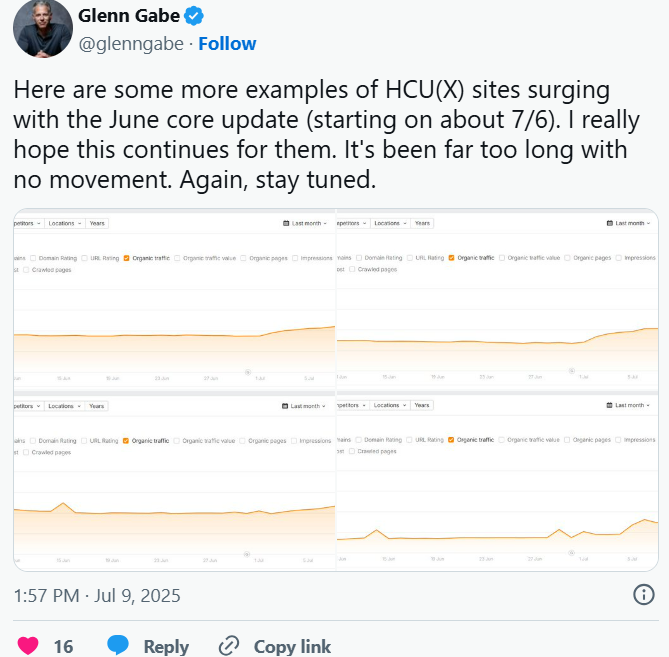
As for rank volatility, things were pretty calm at first, but we saw things heating up dramatically in mid July. According to Sistrix data, movements 'are more prevalent across domains that are focused on informational content types.'
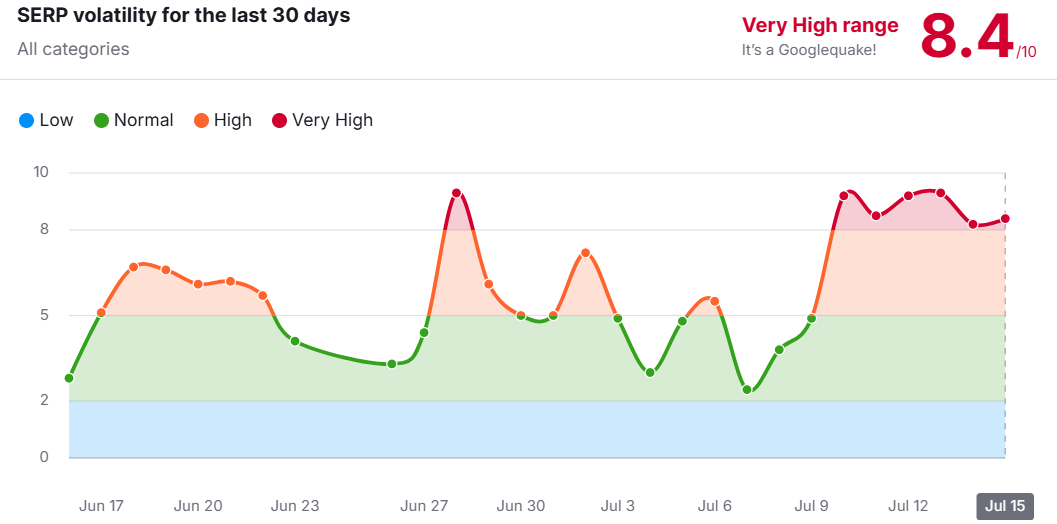
While Google hasn’t confirmed any major changes to ranking systems, there’s been some industry speculation about what may be happening behind the scenes.
In particular, some have pointed to two recent developments that could be related:
-
MUVERA, a new multi-vector retrieval method announced by Google in late June
-
Graph Foundation Models (GFM), an AI architecture that helps interpret complex relationships between data points — including potentially links, entities, or patterns across web content
If these technologies are indeed being deployed (and there's no confirmation they are), they could help Google improve how it identifies highly relevant or trustworthy content. MUVERA, for instance, enables faster, more precise retrieval of pages — potentially reducing noise in the search results. GFM, meanwhile, could allow for more advanced understanding of content relationships, such as link graphs or authoritativeness signals.
If these new systems are in play, it might explain why some previously suppressed sites are now seeing partial rebounds — especially in cases where strong content wasn’t previously being surfaced.
In terms of SEO impact for non-HCU sites, MUVERA and GFM mean that lower relevence content, instead of securing a lower rank, may no longer even be in the race. On the flip side, if your content is truly useful and well-targeted, you might now stand a better chance — even against bigger or more authoritative competitors — because the system may be doing a better job identifying precise relevance.
March 2025 Core Update
- Launched: March 13
- Completed: March 27
- Scale: Global
- Purpose: A broad core update refining Google’s main ranking system — with sharper focus on content helpfulness, site reputation, and spam reduction
- Impact: Widespread ranking volatility — worse for industries in health and finance niches
Similar to the December 2024 core update in impact, the first update of 2025 caused substantial ranking fluctuations, with some industries and sectors seeing more turbulence than others.
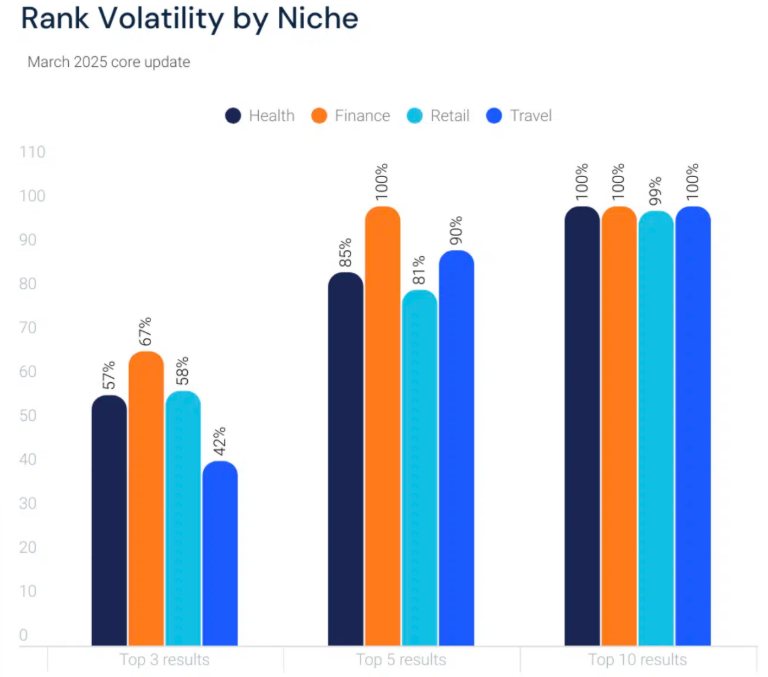
Source: Search Engine Land
Health and finance sites saw the biggest swings in rank, but retail and travel sites were also all over the place during and after the update.
The top 3 positions saw comparatively fewer reshuffles, with the majority of changes occurring within the top 5 and top 10 ranges.
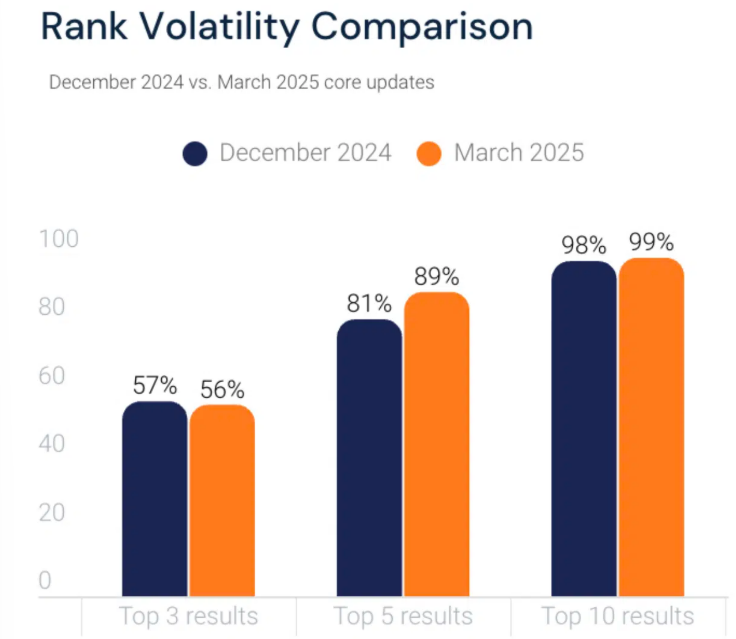
Source: Search Engine Land
Below are lists of the “winners and losers” of the update according to Sistrix:
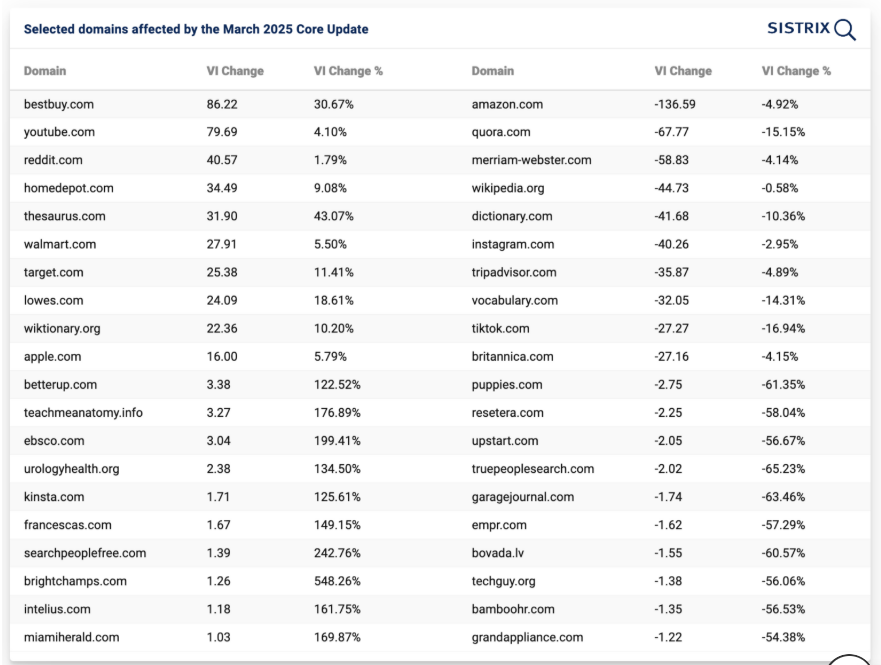
Source: Sistrix
2024 Google algorithm updates
December 2024 Spam Update
- Launched: December 19th
- Completed: December 26th
- Scale: Global
- Purpose: Updated aspects of Google’s SpamBrain to improve the quality of search results
- Impact: Ranking fluctuations and deindexing issues
Google chose not to report which area of their spam policies the December spam update related to. Those affected were simply told to review Google’s spam policies at large and make any necessary adjustments — and that recovery would likely take several months.
December 2024 Core Update
- Launched: December 12
- Completed: December 18
- Scale: Global
- Purpose: Aimed to enhance search result relevance and quality
- Impact: Notable volatility in search rankings, affecting various websites across multiple sectors
The December 2024 core update was launched 8 days after the November update.
Rollout lasted just 6 days, making it the fastest core algorithm update to date. However, the December core update was more severe than its predecessor, triggering an average rank fluctuation of 2.8 positions compared to 2.4 positions in November.
On the back-to-back nature of the 2024 December and November core updates, Google posted the following to X:
‘If you’re wondering why there’s a core update this month after one last month, we have different core systems we’re always improving.’
Subsequently, during a spokesperson from Google’s Search Relations team announced that core updates would arrive more frequently moving forward.
Many of the few HCU sites starting to recover post March 2024 core update reported a regression in the wake of the December core update.
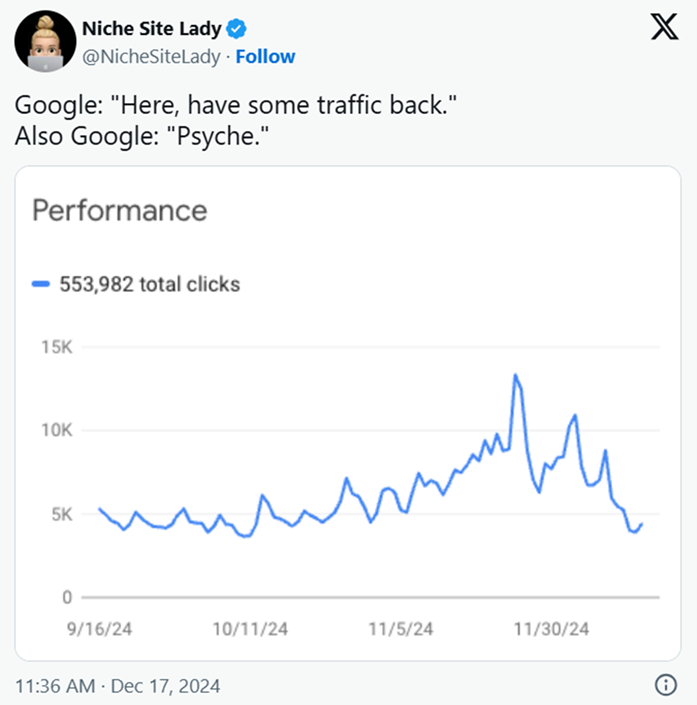
Source: SERoundtable
If your website has lost visibility due to the December 2024 core algorithm update, TDMP can help. Contact us today to kickstart your recovery.
November 2024 Core Update
- Launched: November 11th
- Completed: December 5th
- Scale: Global
- Purpose: Promote relevant, helpful content
- Impact: Significant ranking volatility between positions 21-30. AI Overviews citations become more aligned with SERP positions
While general in scope, Google’s November 2024 core update manifested in some interesting ways, particularly where AI Overviews was concerned.
Research showed that the update coincided with an increased overlap between websites cited in AI Overviews and those ranking in the top 10 positions on Google’s SERPs, underscoring the importance of SEO as AI becomes more integrated with search.
Find out what to focus your SEO resources on in our guide: SEO in 2025: What’s changing - and what no longer matters
Product-focused content saw the most significant fluctuations in citations, diverging from the trend of increased AI Overviews and SERP overlap.
To compensate for this loss of visibility in AI-generated search results, e-commerce brands should focus on creating supporting informational content aimed at answering relevant questions and solving user problems.
Read our full analysis of the November 2024 core algorithm update.
August 2024 Core Update
- Launched: August 15th
- Completed: September 3rd
- Scope: Global
- Purpose: Apply publisher feedback to the algorithm to promote helpful content while demoting content created solely to satisfy search algorithms
- Impact: Wide-spread ranking volatility, particularly in the US. Some HCU websites started to show signs of recovery
Leading up to the launch, Google described this as a routine update aimed at improving search results. However, in a later announcement on their Search Central blog, they revealed that the August update incorporated feedback from creators affected by the previous core update and the September 2023 Helpful Content Update.
Hopes were high among these creators that the August update would therefore help their websites recover, but a majority of HCU sites lost rather than gained ground on the SERPs.
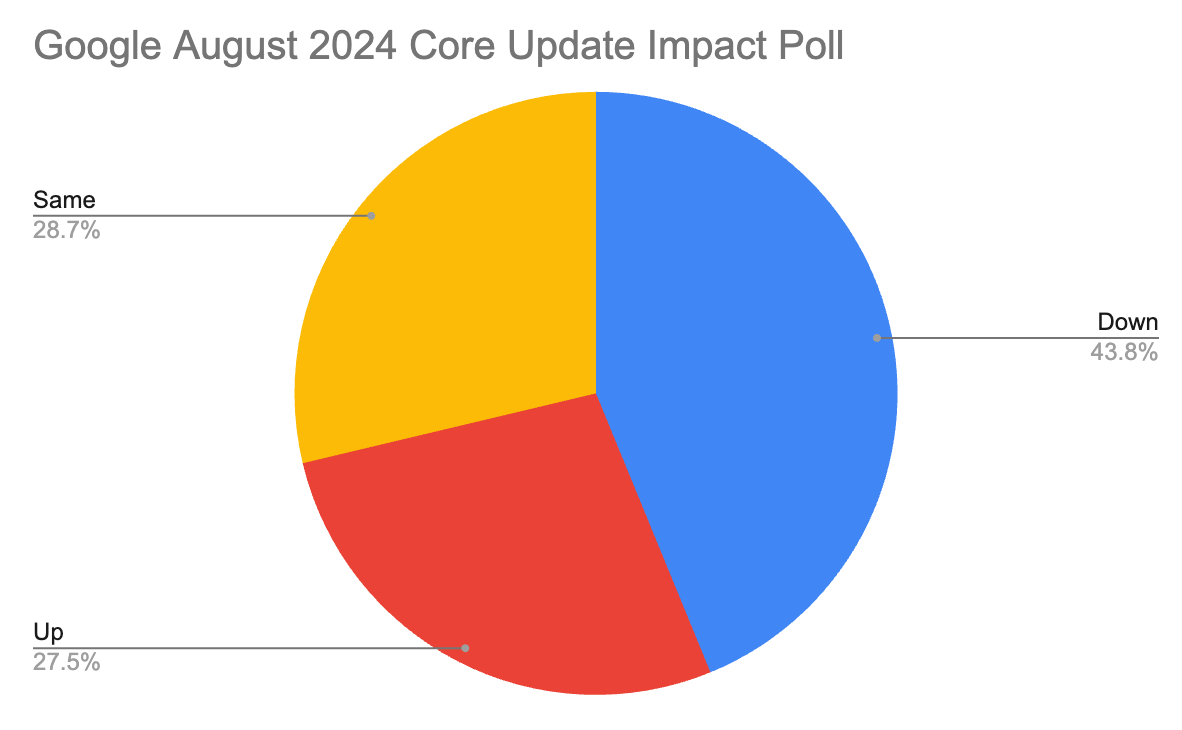
Source: SERoundtable
As this update finished rolling out, Google updated its recovery advice, instructing website owners to wait a week before making changes, to focus only on significant ranking drops, and to opt for user-centric improvements over “quick fixes.”
Read our full analysis of the August 2024 core algorithm update.
March 2024 Core Update
- Launched: March 5th
- Completed: April 19th
- Scale: Global
- Purpose: Reduce approximately 40% of low quality unoriginal content in search results
- Impact: Significant ranking volatility and several websites deindexed
Google’s March 2024 core update was their largest and most significant to date, taking a full 45 days to complete.
Released in tandem with the March 2024 Spam Update, the March Core Update took aim at low quality content, with a particular focus on removing unoriginal AI-generated content from their SERPs.
Does AI plagiarise? Find out in our study.
This was in response to growing user concerns that Google’s results pages were becoming increasingly saturated with generated content, diluting the value of their service.
Results were swift, with over 800 websites completely removed from Google’s search index during the first week of the rollout. Combined, these websites lost over 20.7 million organic visits per month, which equates to an approximate monthly loss of £358,839.
An Originality.ai analysis of sites hit with manual actions during this update found that 50% contained almost entirely AI-generated content (90-100%), while every affected site featured at least some AI-generated posts.
Following rollout completion, Google reported the successful removal of 45% of low quality, unoriginal content from their SERPs — exceeding their forecast of 40%.
Read our full analysis of the March 2024 core algorithm update.
March 2024 Spam Update
- Launched: March 26th
- Completed: April 2nd
- Purpose: Update Google’s spam algorithm to better identify low quality AI-generated content and website authority abuse
- Impact: Websites using manipulative SEO tactics saw ranking drops, with some experiencing penalties or removal from Google’s search index
The March 2024 Spam Update arrived arm-in-arm with three new spam policies covering:
- Expired domain abuse - The use of expired domains to exploit old authority, ensuring better content quality and relevance
- Site reputation abuse - The misuse of reputable domains by hosting low-quality content, relying on the site's authority rather than content value
- Scaled content abuse - The mass production of low-quality content, often generated through automation or AI, aimed at manipulating rankings
Read our full analysis of the March 2024 spam update.
2023 Google algorithm updates
November 2023 Reviews Update
- Launched: November 8th
- Completed: December 7th
- Purpose: Improve Google’s reviews system to enhance the quality of review-based content in search results
- Impact: Wide-spanning search ranking fluctuations. Some webpages experienced substantial visibility changes, with many websites not recovering post-update
Rolling out over the better part of a month, the November 2023 Reviews Update improved Google’s ability to assess the reliability and value of review content at a page level. It aimed to reward in-depth, original insights over generic or superficial reviews.
Sites with thin reviews or those that simply summarised information were likely to be negatively impacted.
This would be the last formally announced review system update. From this point on, small, incremental review updates would play out continuously in the “background”.
November 2023 Core Update
- Launched: November 2nd
- Completed: November 28th
- Scale: Global
- Purpose: Refine search ranking systems to better reward helpful, reliable content and improve overall search quality
- Impact: Significant ranking fluctuations; some sites boosted, others declined, depending on content quality, E-E-A-T, and user intent alignment
Seeming to prefigure the December 2024 core update, Google’s November 2023 core release, the fourth and final of the year, commenced hot on the heels of — and with a slightly more pronounced impact than — its predecessor.
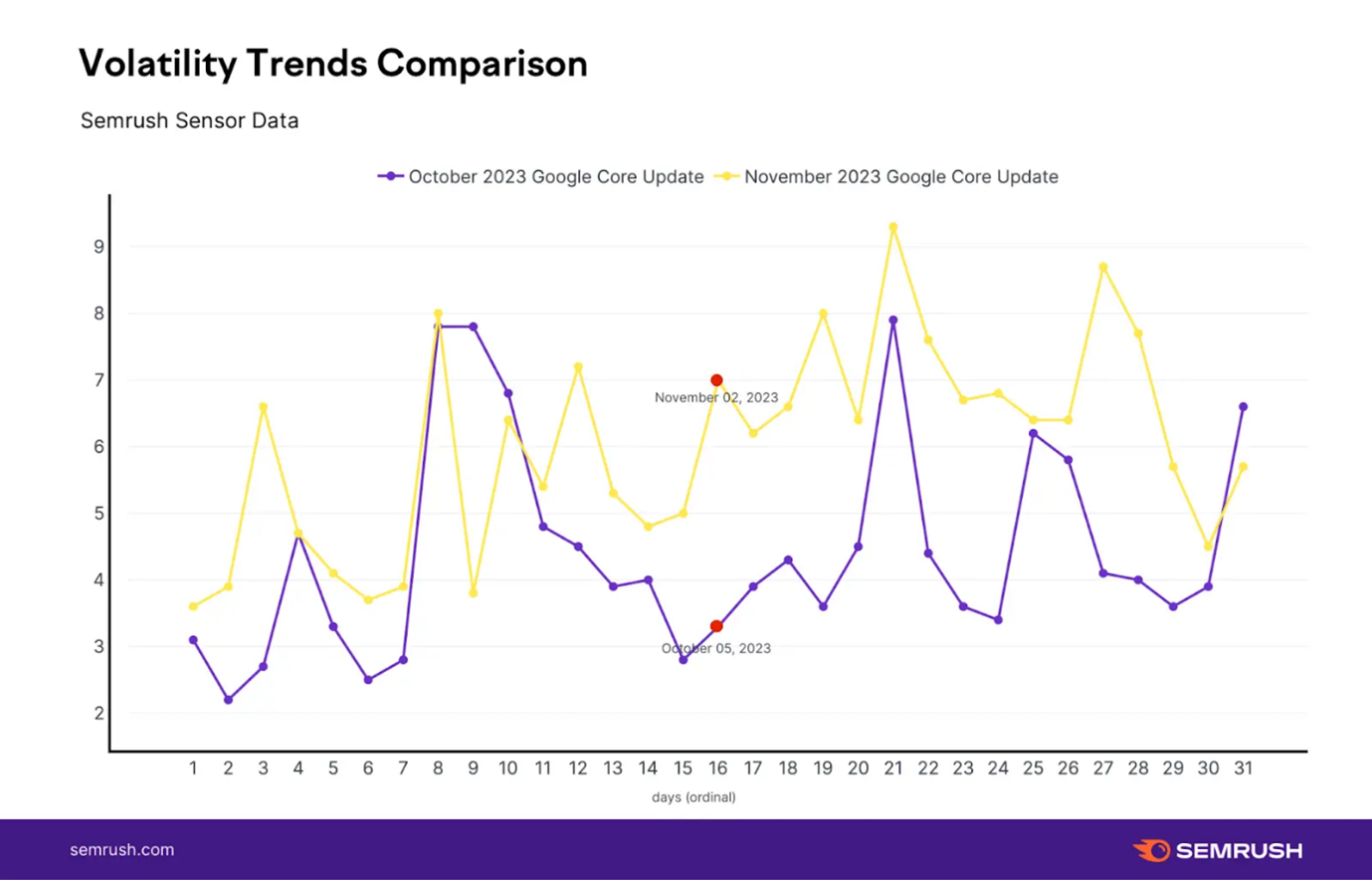
Source: Semrush
On average, the number of positions lost during November update was 2.76, while the average downward trajectory for October was 2.62 positions.
As this update coincided with the November 2023 Reviews Update, those with webpages containing review content found it difficult to distinguish between the effects of the updates. But, as Mordy Orbenstin explains in his analysis, it shouldn’t really matter.
Both updates penalised poor quality content. Regardless of content type — the optimisation and recovery process was more or less the same.
October 2023 Core Update
- Launched: October 4th
- Rollout duration: October 19th
- Scale: Global
- Purpose: Refine search ranking systems to better reward helpful, reliable content and improve overall search quality.
- Impact: Wide-spread, but comparatively minor ranking volatility
On average, the October 2023 Core Update triggered a loss or gain of 2.5 positions, a cooling from the August update of 3 positions
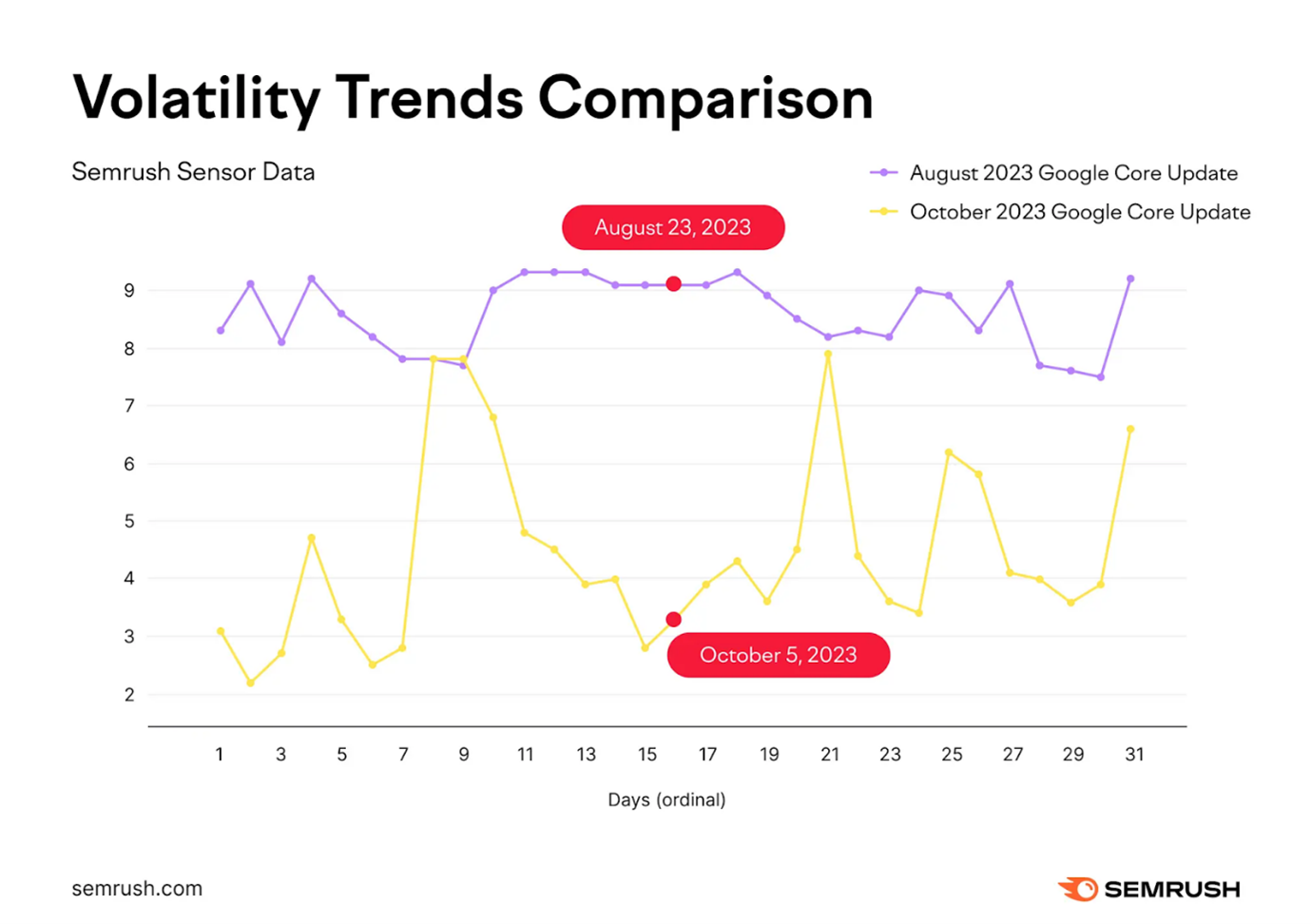
Source: Semrush
That said, on a per-vertical basis, the October update was more volatile in multiple areas. For instance, Arts, Entertainment, Shopping, and Finance verticals showed more intense fluctuations than they did in August.
Due to some ranks reverting, some posited that, in part, the October Core Update was a reversal of August Core Update. However, while Google does work some fixes into each update, there has never been any clear evidence of a true reversal of previous updates.
October 2023 Spam Update
- Launched: October 4th
- Completed: October 19th
- Scale: Global — with particular focus on non-English language regions
- Purpose: Remove various types of spam from search results, including ‘cloaked, hacked, auto-generated, and scraped spam’
- Impact: Sites guilty of relying on these spam techniques to build visibility on the SERPs saw a significant decline in rankings
While the October 2023 Spam Update was rolled out globally to all regions and languages, it was implemented primarily to address concerns of users in non-English language nations.
Upon launching the update, Google stated,
‘This spam update aims to clean up several types of spam that our community members reported in Turkish, Vietnamese, Indonesian, Hindi, Chinese, and other languages. We expect it to reduce the visible spam in search results…’
September 2023 Helpful Content Update
- Launched: September 14th
- Completion: September 28th
- Scale: Global
- Purpose: Enhance the Google Helpful Content System’s proficiency in identifying and promoting content that is genuinely helpful to users
- Impact: Severe decreases in rank for a swathe of websites and webpages deemed to be overly focused on attracting search traffic as opposed to offering genuine, valuable resources to users
The September 2023 Helpful Content Update remains one of Google’s most controversial updates, sparking ongoing debate among publishers worldwide.
Designed to reduce the visibility of content created primarily for search rankings rather than users, the update had a site-wide impact — meaning even a few flagged pages could hurt an entire website’s visibility. As a result, hundreds of websites lost significant traffic and profitability.
Many affected site owners disputed the update’s fairness, insisting their content was human-written, genuinely useful, and aligned with SEO best practices rather than manipulative tactics.
A disproportionate number of small businesses and independent publishers were hit hardest. Despite efforts to recover, few have regained their previous traffic levels.
A subtle change in Google's guidance suggested that this update also marked a softening of their stance on AI-generated content.
Prior to this change, Google held the view that helpful content should be written ‘by people, for people’. After the change, their guidance read:
‘Google Search’s helpful content system generates a signal used by our automated ranking systems to better ensure people see original, helpful content created for people in search results.’
August 2023 Core Update
- Launched: August 22nd
- Completion: September 7th
- Scale: Global
- Purpose: Enhance visibility for high quality content and reduce visibility of low quality content
- Impact: Strong E-E-A-T signals improved website rank, while thin or otherwise lower quality content saw significant declines
The August 2023 Core Update saw a comparatively stable rollout, with gradual, mild ranking fluctuations.
Websites that gained the most ground on the SERPs clearly indicated a strong foundation of experience and expertise — but it wasn’t just about E-E-A-T.
Shifts in keyword rankings suggested Google were adjusting their interpretation of search intent and content relevance.
Platforms such as Reddit, as well as governmental and educational entities faired particularly well in the wake of this update.
Read our full analysis of the August 2023 Core Algorithm Update here.
April 2023 Reviews Update
- Launched: April 12th
- Completion: April 25th
- Scale: Global
- Purpose: Improve search results by rewarding websites with detailed, experience-based reviews — on products or otherwise
- Impact: Websites featuring review content that clearly showcased first-hand experience with the product/service increased in rankings. Those that didn’t saw significant declines
The April 2023 Reviews Update had a broader scope than its predecessors, taking all review content into account — as opposed to just product reviews. This included reviews of:
- Businesses
- Services
- Destinations
- Media, i.e. films, games, outlets, etc.
The road to recovery for those hit by this update primarily involved ensuring review content was unique, detailed, and offered personal insight.
March 2023 Core Update
- Launched: March 15th
- Completion: March 28th
- Scale: Global
- Purpose: Improve the relevance and quality of search results
- Impact: Significant rank volatility. High quality content sites climbed the ranks, while low quality content fell
The March 2023 Core Update was characterised by significant but short-lived volatility on the SERPs
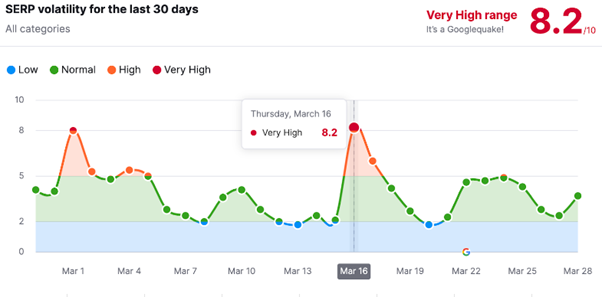
Source:Semrush
This turbulence was felt across all industries, but the following verticals endured the worst of it, all scoring 6 or above on Semrush’s volatility charts::
- Arts & Entertainment
- Beauty & Fashion
- Business & Industrial
- Computers & Electronics
- Finance
- Games
- Internet & Telecom
- Shopping
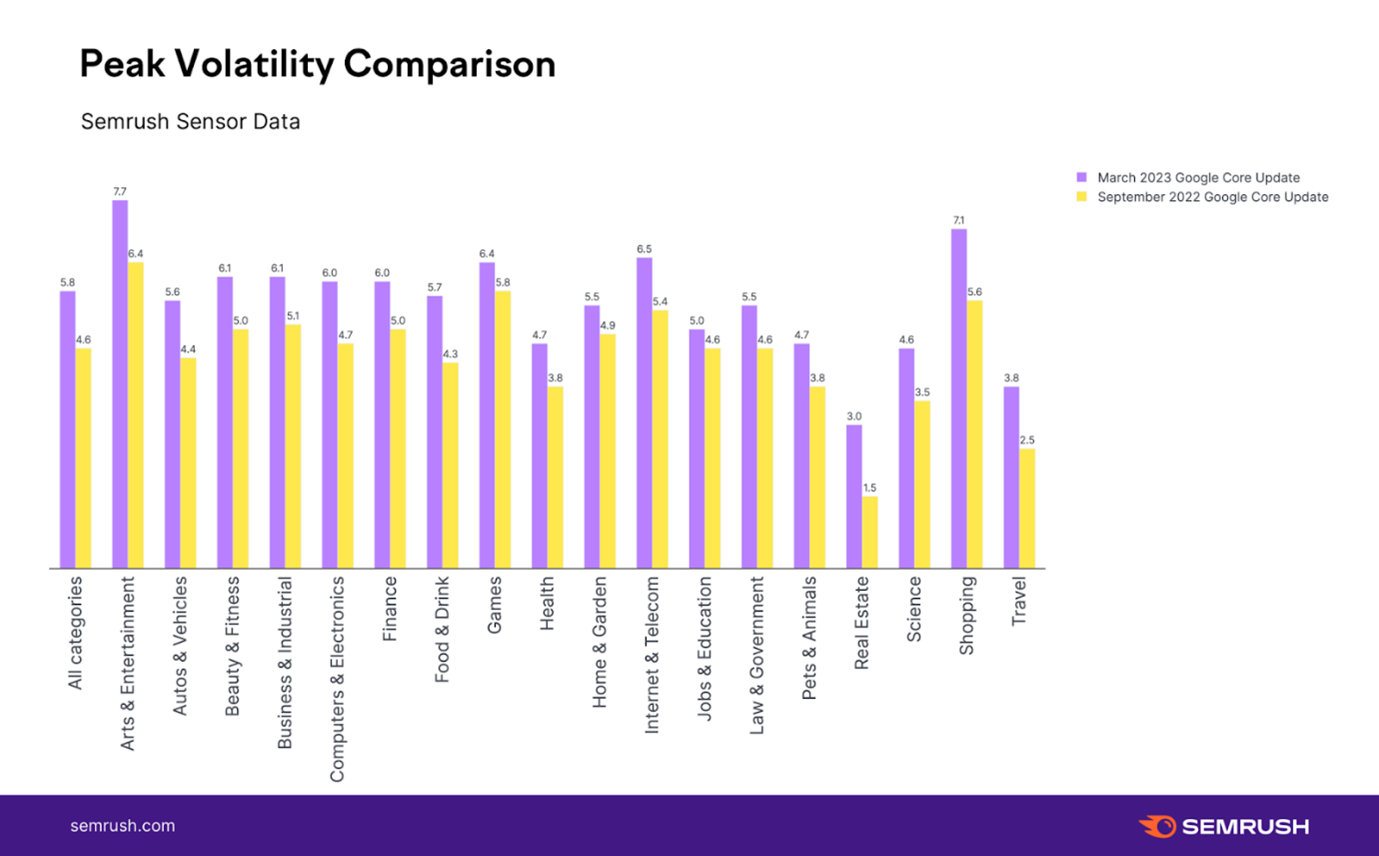
Source: Semrush
February 2023 Product Reviews Update
- Launched: February 21st
- Completion: March 7th
- Scale: Affected search results in English, Spanish, German, French, Italian, Vietnamese, Indonesian, Russian, Dutch, Portuguese, and Polish
- Purpose: Enhance the quality of product reviews in search results by rewarding in-depth, experience-based content and demoting superficial or low-quality reviews
- Impact: Sites with thin, duplicate, or fake product reviews declined in rank
This marked the first time a reviews update targeted more than English-language SERP results alone.
Sites featuring summary reviews with little evidence of personal experience found themselves in Google’s crosshairs.
Google also took this opportunity to refresh their review update documentation, shifting the focus to their Product Reviews System itself, rather than the updates that influence it.
2022 Google algorithm updates
December 2022 Link Spam Update
- Launched: December 14th
- Completed: January 12th
- Scale: Global
- Purpose: Launch SpamBrain to detect and neutralise unnatural links, including purchased links and those from sites designed primarily to pass link authority
- Impact: Websites involved in link schemes or using unnatural links saw ranking drops, while those following Google's guidelines maintained stability or improved
With the December 2022 Link Spam Update, Google introduced SpamBrain to the world — an AI system designed to comprehensively combat the use of spammy links to manipulate search rankings.
SpamBrain was designed to identify bought links and detect the root cause of the issue: websites primarily used to distribute links to other sites.
This meant, for the first time, Google wasn’t just targeting “real” websites; they were trying to control the entire link spam ecosystem.
Yet, despite the broad scope of this update — and the fact rollout ran 2 weeks over forecast — offending sites weren’t punished as such. Google made it clear that the goal was to neutralise, not penalise.
This meant that any ranking boost previously gained from those unnatural links would be lost, but the site itself wouldn't necessarily face a direct penalty unless other spam issues were present.
December 2022 Helpful Content Update
- Launched: December 5th
- Completed: January 12th
- Scale: Global
- Purpose: Enhance search results by improving Google’s automated machine-learning system’s ability to identify low quality and unhelpful content across all languages and regions
- Impact: Low-quality, search-engine-first content was deprioritised worldwide
The December 2022 Helpful Content Update expanded Google's Helpful Content System to all languages globally.
Prior to this, the Helpful Content System primarily focused on English-language content.
This update more aggressively targeted unhelpful, AI-generated or mass-produced content, and enforced a site-wide impact where low-quality pages could drag down an entire domain. Recovery for those affected was a slow process, with improvements taking months to pay off.
October 2022 Spam Update
- Launched: October 19th
- Completed: October 21st
- Scale: Global
- Purpose: Improve Google’s spam detection capabilities — particularly link scam
- Impact: Websites employing spam techniques contrary to Google's guidelines experienced declines in search rankings or removal from search results
Rolled out in just 2 days, the October 2022 Spam Update was the first major spam upgrade since the implementation of the August 2022 Helpful Content Update. It underscored the multifaceted efforts Google was making to push for higher quality, user-focused content.
Unlike spam updates that came before it, the October 2022 Spam Update was rolled out in all languages rather than just English.
Recovery was dependent on websites aligning content and operations with Google’s spam policies.
September 2022 Product Reviews Update
- Launched: September 20th
- Completed: September 26th
- Scale: English-language only
- Purpose: Reward review content that genuinely aids consumers in making informed purchasing decisions
- Impact: Webpages with thin, low information or summary review content were down-ranked. Quality reviews based on first-hand experience received a boost
As the fifth instalment of Google’s push to improve product review quality, the September 2022 Product Reviews Update was more of an algorithm refinement than overhaul.
It placed continued emphasis on trust and depth, encouraging the use of original photos, videos, or detailed testing data to serve as proof of first-hand reviewer experience.
This was the first product reviews update not paired with a core update, which should have reduced ranking volatility and made it easier for publishers to track the direct impact on their review content. However, it ended up overlapping with the September 2022 core update, which created some confusion.
September 2022 Core Update
- Launched: September 12th
- Completed: September 26th
- Scale: Global
- Purpose: Enhance the relevance and quality of search results by refining Google's ranking algorithms
- Impact: Websites with high-quality, authoritative content saw improvements in rankings, while those with low-quality or less relevant content experienced declines
The September 2022 broad core update was the second of the year. Like previous core updates, its goal was to improve the quality and relevance of search results by assessing content through the E-E-A-T framework. However, this update appeared to place even greater emphasis on authority and expertise.
Websites well regarded within their niche generally saw improved performance on the SERPs, while those lacking in authority were most at risk of losing ground.
The greatest volatility was observed among the following verticals:
- E-commerce/shopping
- Health & Wellness
- Finance
- Travel
- News & Media
August 2022 Helpful Content Update
- Launched: August 25th
- Completed: September 9th
- Scale: English-language only
- Purpose: Reward content produced for people rather than search engines
- Impact: Websites with unhelpful content or content that aimed to manipulate algorithms were down-ranked
The August 2023 Helpful Content Update introduced the “people–first” signal in Google’s ranking algorithms, focused on identifying content created primarily for search engine rankings rather than for users.
It placed emphasis on addressing user intent with content, ensuring relevance and a higher chance of ranking for target keywords.
To guide recovery, Google suggested that:
- Content should satisfy an ‘existing or intended audience’ if they visit your site directly.
- Content should demonstrate expertise and first-hand experience.
- Websites should have a ‘primary purpose or focus’.
- Content should satisfy user intent, ensuring users learn enough to accomplish their intended goal.
- Content should encourage a positive user experience.
Read our full coverage of the August 2022 Helpful Content Update here.
July 2022 Product Reviews Update
- Launched: July 27th
- Completed: August 2nd
- Scale: English-language only
- Purpose: Promote high-quality, insightful, and original product reviews that provide genuine value to users
- Impact: Websites with detailed, well-researched product reviews saw improvements in rankings
The July 2022 Product Reviews Update encouraged publishers to ‘evaluate [reviews] from a user’s perspective’.
Although there was no real penalty for offending websites, reviews cobbled together using rehashed information from manufacturer descriptions or other sources would perform poorly compared to those that showcased first-hand experience and in-depth analysis.
May 2022 Core Update
- Launched: May 25th
- Completed: June 9th
- Scale: Global
- Purpose: To improve the overall relevance of search results, making them more helpful and useful for users
- Impact: Websites with high-quality, authoritative content saw improvements in rankings, while those with low-quality or less relevant content experienced declines
The May 2022 Core Update, while broad in scope, gave big-name e-commerce sites the most significant overall visibility boost.
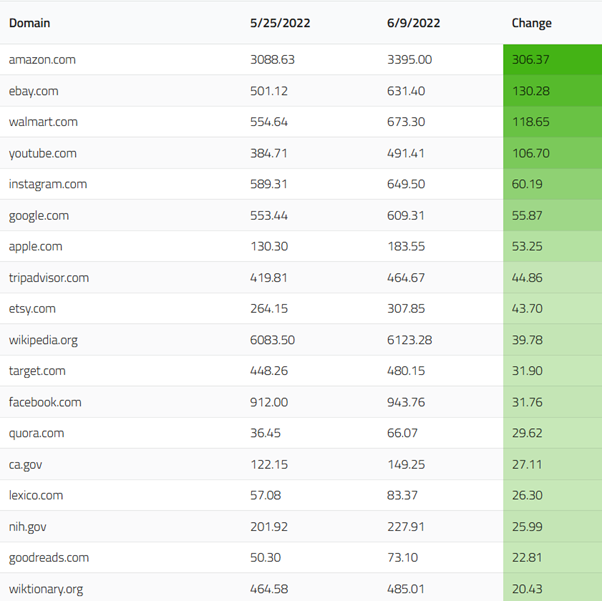
Source: Amsiv
News and media sites with a general focus endured the most significant collective decrease in visibility, closely followed by reference websites, such as online dictionaries, lyrics sites, and stock photo sites.
These results underscored Google’s goal of meeting user search intent on their SERPs, and that sites with a more general focus, while loosely relevant to a board range of queries, are not as relevant to specific queries as focused content.
March 2022 Product Reviews Update
- Launched: March 23rd
- Completed: April 11th
- Scale: Global
- Purpose: Improve Google's ability to identify high-quality product reviews that provide genuine value to users
- Impact: Increased ranking for websites with high quality product reviews
Google’s Alan Kent reported that the March 2022 Product Reviews Update “builds upon” the foundation established by the prior 2 product review updates, making it easier for Google to “identify high quality produce reviews… get sound purchasing advice in front of users, and reward creators who are earnest in being helpful.”
The following guidance was also provided:
- Provide in-depth details: Include specifics like the benefits or drawbacks of the product, how it performs, and how it compares to previous versions.
- Share real user experiences: Reviews should come from people who have actually used the product, detailing the product's physical characteristics or how it's used in real-life scenarios.
- Offer unique insights: Go beyond the manufacturer’s description by adding original content, such as visuals, audio, or links to further resources that showcase the reviewer’s personal experience.
- Compare with competitors: Provide insights on how the product stacks up against others in the same category, or explain what makes it stand out from the competition.
2021 Google algorithm updates
December 2021 Product Review Update
- Launched: December 1st
- Completed: December 21st
- Scale: English-language only
- Purpose: Improve Google's ability to identify high-quality product reviews that provide genuine value to users
- Impact: Insightful reviews with evidence of first-hand experience climbed the SERPs — pushing lower quality reviews down the ranks
The follow-up to the April 2021 Product Reviews Update incorporated user feedback collected by Google — on what makes a product review trustworthy and helpful.
While it was designed to better identify and reward insightful and original reviews (particularly those written by subject-matter experts), content that included evidence of product testing and the option to purchase products from more than one vendor would benefit the most.
November 2021 Local Search Update
- Launched: November 30th
- Completed: December 8th
- Scale: Global
- Purpose: Refine local ranking signals to deliver more relevant and accurate local search results
- Impact: Improved rankings for businesses with accurate, complete Google Business Profiles
Dubbed the “Vicinity Update” by publishers, the November 2021 Local Search Update focused on “rebalancing” Google’s local ranking factors:
- Relevance - Is your business profile relevant to a query?
- Proximity - How far is your business away from the searcher or the location term used in the query?
- Prominence - Is your business well known?
It’s clear that this update gave the lion’s share of ranking power to proximity because, as long as they were closer to the user or location specified in the query, smaller businesses were outperforming bigger names, and sub-par profiles were appearing ahead of well-maintained profiles.
A more detailed analysis revealed that those that benefitted the most were:
- Businesses that hadn’t placed keywords in their business profile name — but had competitors that did
- Secondary sites of businesses with a more established primary location
By contrast, those that endured the biggest loses were:
- Businesses that were previously ranking for queries focused on comparatively distant areas
- Businesses that had placed keywords in their profile business name — as this was now considered a form of spam
November 2021 Core Update
- Launched: November 17th
- Completed: November 30th
- Scale: Global
- Purpose: Refine ranking algorithms for overall content quality and relevance
- Impact: Subtle shifts in rankings — in favour of authoritative content and websites
SERP volatility spiked violently as rollout of the November 2021 Core Update commenced, cooling almost immediately by the 19th.
The biggest winners were encyclopoedic reference sites — we’re talking Wikipedia, Wiktionary, imbd, Collinsdictionary.com, Cambridge.org, Dictionary.com, etc.
Social networking and news platforms were hit the hardest, including Pinterest, LinkedIn, Forbes, Reuters, APN, etc.
November 2021 Spam Update
- Launched: November 3rd
- Completed: November 11th
- Scale: Global
- Purpose: Enhance Google's ability to detect and neutralise spammy content
- Impact: Sites engaged in spammy tactics saw ranking declines
November welcomed the fourth and final spam update of the year. This one focused on content spam, and those impacted were urged to review Google’s webmaster guidelines and make any necessary changes.
Some also advised reviewing site security and checking for signs of a cyberattack — as this can lead to the publishing of spam without the website owner’s knowledge.
July 2021 Link Spam Update
- Launched: July 26th
- Completed: August 9th
- Scale: Global
- Purpose: Enhance Google's ability to identify and nullify link spam
- Impact: Websites using manipulative link-building tactics, such as unnatural link exchanges, experienced ranking declines
The July 2021 Link Spam Update emphasised the importance of transparency when handling links that involve an exchange of value, such as paid or affiliate links.
Site owners were advised to be cautious with such links and were reminded to use appropriate tags, like "nofollow" or "sponsored," to indicate the nature of these relationships.
July 2021 Core Update
- Launched: July 1st
- Completed: July 12th
- Scale: Global
- Purpose: Refine ranking algorithms to assess content quality and relevance
- Impact: Major ranking volatility across certain industries
You can rarely mark a Google core update in your diary ahead of time, but the July 2021 Core Update was different.
Comprising improvements Google planned a month prior but never quite managed, they announced the need for a follow-up immediately.
As a minor update to tie up the loose ends of the June 2021 Core Update, the SERPs were generally quite stable, but not for everyone…
Websites in science, real estate, beauty & fitness, shopping, and pets & animal niches experienced the full force of the algorithm adjustment.
June 2021 Spam Updates
- Launched: June 23rd & 28th
- Completed: June 23rd & 28th
- Scale: Global
- Purpose: No mention of specific targets
- Impact: Spammy webpages and images down-ranked or removed
Google never commented on the specifics of these updates. They were both launched and completed in just one day, alongside generic guidance from Google to review their spam guidelines if affected.
It was reported that both webpages and images (appearing in image search) were impacted.
June 2021 Page Experience Update
- Launched: June 16th
- Completed: September 2nd
- Scale: Global
- Purpose: Prioritise web pages that offer better user experiences
- Impact: Poor UX webpages were down-ranked. Encouraged a more holistic view of user experience among publishers
The June 2021 Page Experience Update fundamentally shifted Google's ranking priorities, placing a greater emphasis on user experience alongside content relevance.
Core Web Vitals, like LCP, FID, and CLS, became crucial metrics, driving website owners to optimise site speed, responsiveness, and visual stability.
To help optimisation along, Google introduced a Core Web Vitals report tool and Search Results Performance report tool.
The update had a direct business impact, as websites with optimised page experience saw potential increases in user engagement and conversion rates, while those with poor performance risked traffic loss.
It also updated the requirements for Accelerated Mobile Pages (AMP) and reduced the importance of AMP for appearing in the Top Stories carousel.
Read our full analysis of the June 2021 Page Experience Update here.
June 2021 Core Update
- Launched: June 2nd
- Completed: June 12th
- Scale: Global
- Purpose: Improve Google’s ability to assess content quality and relevance
- Impact: Significant SERP volatility
The June 2021 Core Update didn’t quite accomplish all Google had hoped, so they immediately announced the July update as a follow-on. This gave the Google team time to finish the planned upgrades whilst also presenting an opportunity to get them rolled out efficiently.
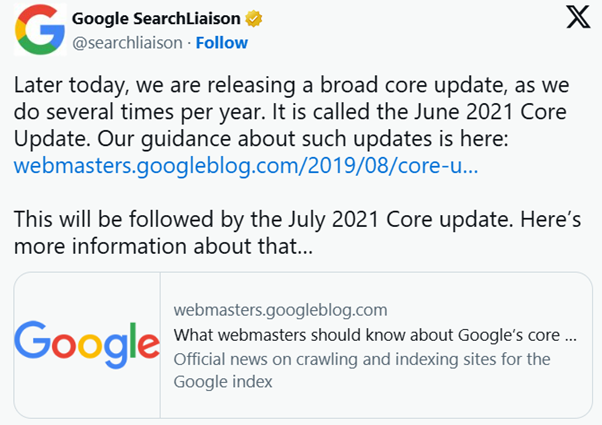
With this update’s second instalment imminent, Google urged publishers not to act rashly in response to declines in performance — as changes did not reflect the complete impact of the update.
After a relatively calm start, ranking volatility eventually set in around June 6th, with Mobile SERPs marginally more turbulent than desktop.
Websites centered on local infrastructure or helping users discover nearby businesses saw the most significant gains from this update. More broadly, the biggest winners were sites in the food and drink, law and government, and internet and telecommunications categories.

Source: Semrush
Websites with monthly traffic between 50k and 500k saw the most significant declines in rank.

Source: Semrush
As rollout came to a close, most industries were experiencing high volatility, revealing the broad scope of the update.
May 2021 MUM Update
- Announced: May 18th
- Scale: Global
- Purpose: Improve Google algorithms’ ability to handle complex queries
- Impact: Accelerated and reinforced shift towards semantic SEO
While MUM (Multitask Unified Model) wasn’t technically an update — rather a new technology — it’s impact and relevance make it important to cover here.
MUM is an AI model that was designed to improve Google’s ability to interpret search queries.
It was claimed that MUM was 1000 times more efficient than BERT — the system it replaced. While BERT was capable of understanding simple queries and clear search intent, MUM could handle significantly more complex, nuanced, and multi-faceted searches.
It could understand information across different languages, modalities (text, images, video), and contexts, allowing it to synthesise information and provide more comprehensive and direct answers. This meant that instead of requiring multiple searches to piece together an answer, users could potentially get a more complete understanding in a single search.
April 2021 Product Reviews Update
- Launched: April 8th
- Completed: April 22nd
- Scale: English-language product reviews globally
- Purpose: Improve user experience by increasing visibility of pages and websites with in-depth, unique product reviews
- Impact: Certain sites with review content plummeted in rank
The April 2021 Product Reviews Update was the first of its kind, designed to boost visisbility for in-depth product reviews that demonstrate expert knowledge and first-hand experience with the products.
Even though the update focused on review content, data analysts struggled to see any overarching pattern suggesting a disproportionate amount of review sites were hit.
That said, there were some severe individual cases highlighted, including experiencemommy.com:
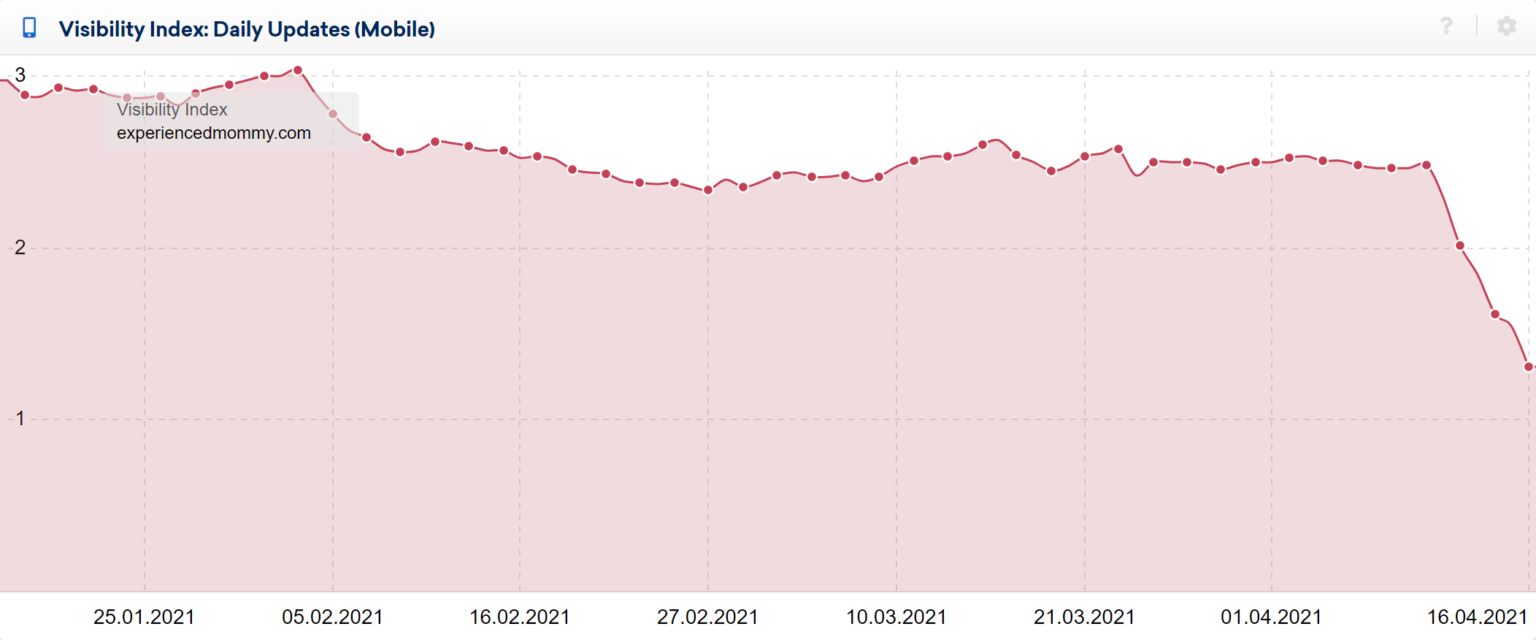
Source: Sistrix
2020 Google algorithm updates
December 2020 Core Update
- Launched: December 3rd
- Completed: December 16th
- Scale: Global
- Purpose: Improve Google’s ability to assess overall web page relevance
- Impact: Big swings in rank for a broad range of websites and industries
Closing out the year, Google’s December 2020 Core algorithm update was far more expansive than its predecessor in May.
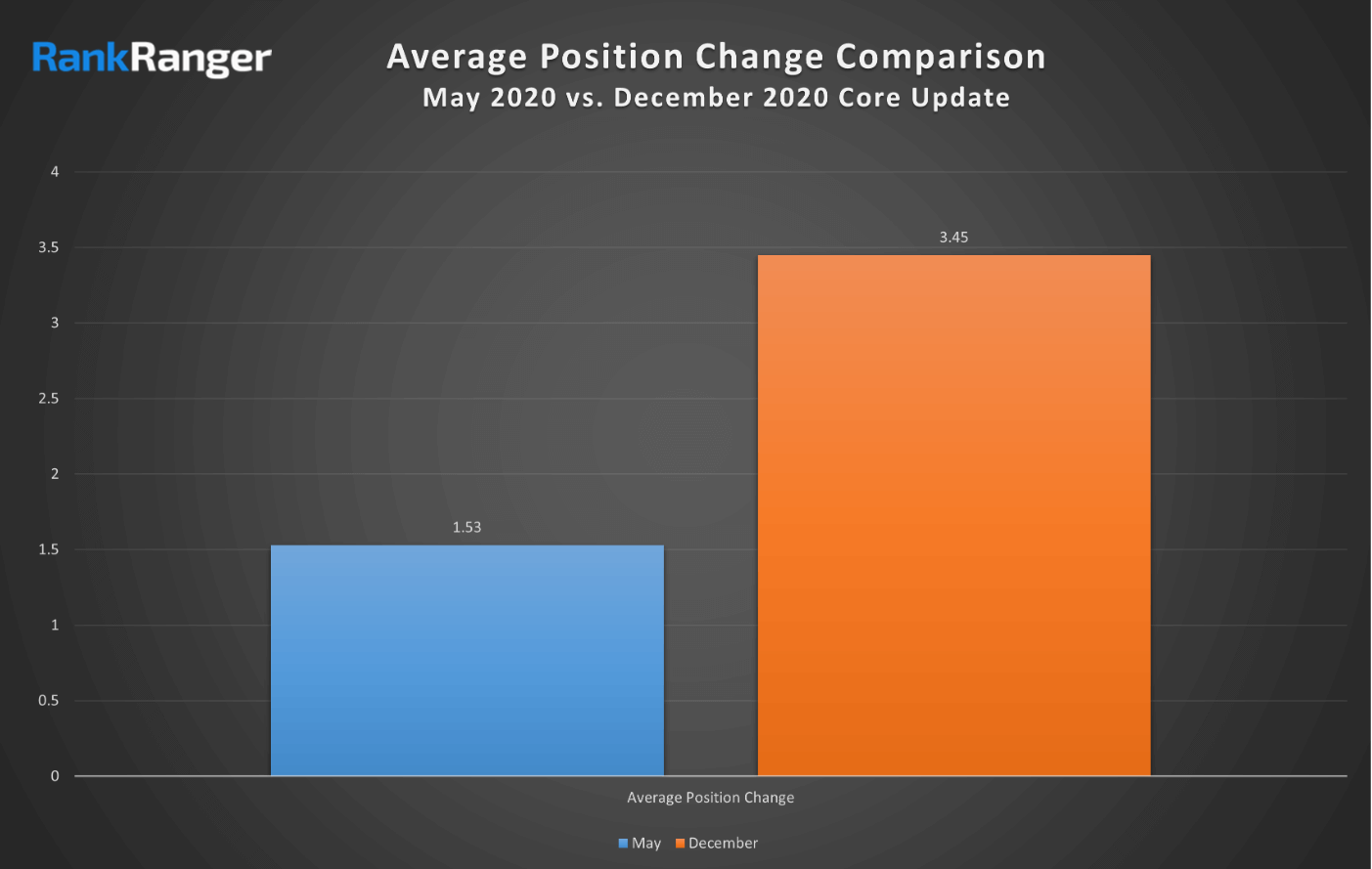
Source: Searchengineland
Due to the timing of this update, many online retailers were particularly concerned about how it would impact their traffic — and they were right to be.
Retail was the most heavily affected industry, closely followed by finance, health and, to a lesser degree, travel. Semrush reported that the biggest winners and losers were…
Winners:
- Zoominfo
- Whitepages
- Ebay
- Vimeo
- Yahoo
- Foursquare
- Businesswire
Losers:
- Yellowpages
- Newsbreak
- Gettyimages
- Wish.com
- Echovita
- Urbandictionary
- Local.com
- Dnb
- Alieexpress
September 2020 mobile-first indexing
- Announced: 2020
- Completed: 2023
- Scale: Global
- Purpose: Prioritise the mobile version of a website's content for indexing and ranking, reflecting the dominance of mobile internet usage
- Impact: Websites that were not mobile-friendly risked significant ranking declines
Google had been tinkering away at mobile-first indexing since 2016, but in 2020 announced that they would fully transition to a mobile-first approach for the entire web — starting September.
This change responded to the surge in mobile searches, which had surpassed desktop searches as early as 2014.
The switch to mobile-first indexing was a long-game adjustment, with Google transitioning the last batch of sites in May, 2022.
May 2020 Core Update
- Launched: May 4th
- Completed: May 18th
- Scale: Global
- Purpose: Help Google’s systems to better understand and rank content
- Impact: One of the most volatile updates in years, with widespread ranking shifts across industries
May 2020 brought another sizeable update — measurably larger than the already substantial January 2020 Core Update.
Average position change rose from January’s 8 points to between 9 and 9.4 points for almost every category. That said, some categories faired better than others…
News websites came out on top, while Arts & Entertainment, Online Communities, Business & Industrial, and Games categories took the biggest hits.
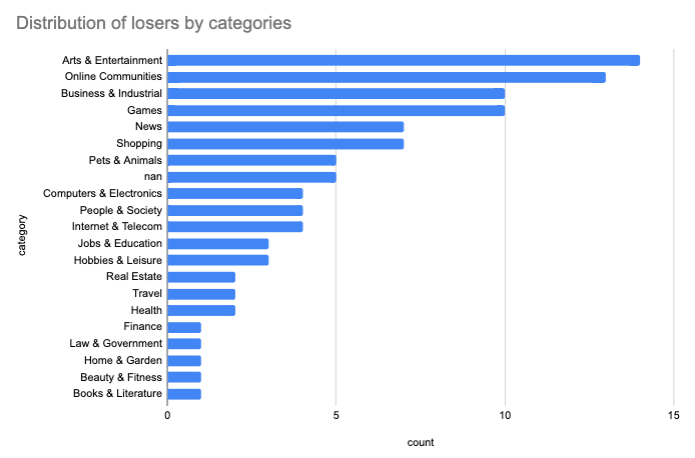
Source: Semrush
Patterns tracked and shared by the SEO community seemed to suggest that the update had a particular focus on E-E-A-T signals, as websites with strong adherence to this framework — such as having high quality backlinks — rose through the ranks. Those with weaker signals fell the farthest.
January 2020 Core Update
- Launched: January 13
- Completed: January 16
- Scale: Global
- Purpose: Refine relevance and quality signals across a broad range of content types and industries
- Impact: Notably affected YMYL (Your Money, Your Life) sites; thin content penalised
Google kicked off 2020 with a broad core update that sent ripples through nearly every niche — but YMYL sites bore the brunt of the impact.
Sites with stronger E-E-A-T signals tended to outperform those with outdated or superficial content. For example, within the medical space, some sources saw large drops while others surged — depending largely on perceived authority and content depth.
This update reinforced the growing importance of comprehensive, trustworthy information, especially when content could influence critical life decisions like health or finances.
2019 Google algorithm updates
October 2019 BERT Update
- Launched: October 21
- Completed: October 27
- Scale: English-speaking nations (initially)
- Purpose: Improve understanding of natural language and query context
- Impact: Affected 10% of English-language queries; especially impactful for long-tail, conversational searches and featured snippets
BERT (Bidirectional Encoder Representations from Transformers) marked a major leap in Google’s ability to process natural language. Unlike previous models, which looked at words sequentially, BERT allowed Google to interpret words in context — examining both the words that come before and after a term in a query.
The change had a big impact on long-tail queries and voice searches, enabling more accurate results for nuanced, conversational questions. It also improved the relevance of featured snippets by helping Google understand what users meant — not just what they typed.
Google described this as one of the most significant leaps forward in the past five years, and its introduction laid the groundwork for even more sophisticated AI-driven updates in the future.
Read our initial coverage of the BERT update announcement here.
September 2019 Core Update
- Launched: September 24
- Completed: ~ September 27
- Scale: Global
- Purpose: Continue refinement of core ranking signals, particularly around trust and authority
- Impact: Affected sensitive E-E-A-T sectors (e.g. health, finance); video carousels increasingly displaced traditional top results
The September 2019 update continued Google’s push for better-quality content, with a noticeable focus on sensitive topics like finance and health. E-E-A-T signals once again played a key role in which domains rose or fell.
One of the more curious shifts observed was in video content. Sites that previously held the top spot for informational queries found themselves bumped down by video carousels, suggesting a stronger emphasis on multimedia results.
As with other core updates, there were no specific penalties — just a recalibration of how relevance and authority were weighted across different sectors.
August 2019 Featured Snippet Update
- Launched: August 1
- Completed: Early August
- Scale: Global
- Purpose: Improve the relevancy, accuracy, and freshness of featured snippets
- Impact: Outdated or imprecise snippet content was downgraded; newer, more accurate pages were prioritised
This update targeted the quality and timeliness of featured snippets — the answer boxes that appear at the top of many search results. Google aimed to better distinguish between evergreen content and information that had become outdated.
The algorithm was adjusted to weigh the recency and relevance of snippet content more heavily, meaning pages that were once featured could lose their spot if newer or more accurate alternatives emerged. This was particularly impactful in fast-moving sectors like tech, health, and finance, where information evolves quickly.
June 2019 Diversity Update
- Launched: June 6
- Completed: June 8
- Scale: Global
- Purpose: Limit the number of search results from the same domain on a single SERP
- Impact: Helped surface a wider range of domains, especially for transactional queries
Announced shortly after the June 2019 core update, the Diversity Update was designed to address concerns about SERP domination — where one domain could appear multiple times on a single page of search results.
The change aimed to cap results at a maximum of two listings per domain, allowing smaller or less-established websites a better chance to compete. Google noted that this adjustment mostly affected transactional queries, where e-commerce giants had often flooded the SERPs.
Despite gaining a lot of attention, this update was comparatively minor, even within it’s highly focused context. A Moz study conducted after rollout tracked domain diversity on Google’s SERPs over a 30-day period. It revealed that while progress had been made, at 0.49%, it was extremely minimal.
The below chart with a 10x zoom illustrates this minor change:

Source: SearchEngineLand
Read our full analysis of the June 2019 Diversity Update here.
June 2019 Core Update
- Launched: June 2
- Completed: June 8
- Scale: Global
- Purpose: Broad refinement of core ranking systems, with an emphasis on authority and user value
- Impact: E-E-A-T continued to be critical, particularly in YMYL sectors; video carousels saw wider rollout
The June 2019 Core Update caused notable movement in the rankings. Health, finance, and law sectors were again in focus, as Google continued sharpening its understanding of expertise and trustworthiness.
Many of the websites that had improved content quality and overall user experience since the previous update recovered.
Additionally, a rise in video carousels — especially on desktop — pointed to Google doubling down on visual content for certain types of queries. This reinforced the growing need for multimedia optimisation alongside written content.
March 2019 Core Update
- Launched: March 12
- Completed: Mid-March
- Scale: Global
- Purpose: Rebalance rankings to reward pages that were previously under-recognised
- Impact: Health sites endured significant rank fluctuations
With the March 2019 core update came speculation that Google had reversed the previous core update (Medic), due to an apparent reversal of fortunes:
Many of the websites that benefitted the most from the Medic update now saw significant drops in rank, while many of the sites hit the hardest started to recover.
However, this theory was largely discounted due to the fact that several sites lost rank during both updates or gained rank during both updates. Instead, the SEO community began discussing the possibility of a “softening” rather than “reversal” of Medic algorithm changes.
While Google never confirmed this was the case, during an Office-Hours Hangout video, John Mueller revealed that if Google feels a previous update either went too far or didn’t go far enough, it would inform the next update in sequence.
It’s interesting to note, however, that Google wouldn’t necessarily see the updates in question as related. Rather, they see each iteration as a new state. This is likely because, even if a new update intentionally softened or exaggerated the impact of the one that came before it — this would only be a very small part of changes implemented.
2018 Google algorithm updates
August 2018 Medic Update
- Launched: August 1
- Completed: August 9
- Scale: Global
- Purpose: Improve quality rankings
- Impact: Dramatic changes in YMYL rankings; strong E-E-A-T signals became critical
Dubbed the “Medic Update” by the SEO community, this core algorithm adjustment had a disproportionate impact on health and wellness domains — although Google never confirmed a focus, and it should be noted that the update’s effects reached far beyond those categories.
Data from Moz showed shifts in visibility across industries like beauty, vehicles, hobbies, and entertainment, hinting at a broader effort by Google to reward well-established authority sites and demote lower-quality content.
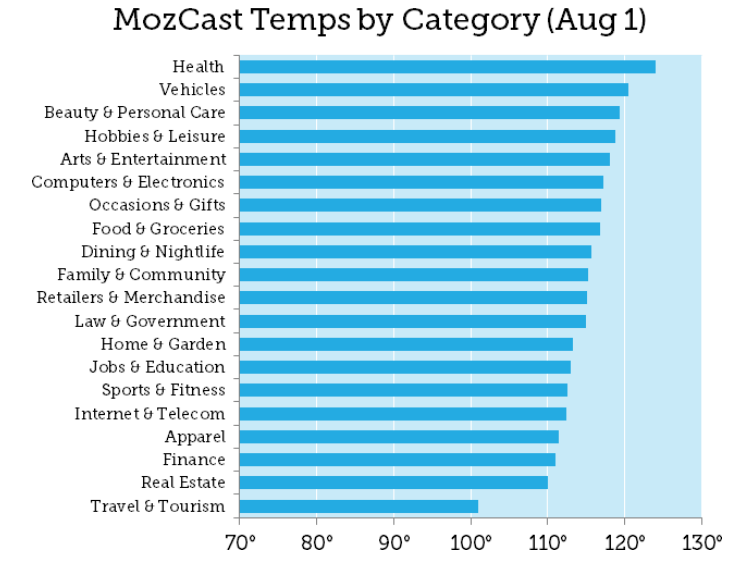
Source: Moz
A second study conducted by Barry Schwartz of Search Engine Round Table analysed over 300 domains impacted by the update. As you can see in the below pie chart, just under half of those monitored were health and medical domains.

Source: SearchEngineLand
Chatter among the SEO community at the time suggested this update reinforced the importance of E-E-A-T. Recovery advice was standard: Create high quality content that satisfies search intent.
April 2018 Core Update
- Launched: April 16
- Completed: April 20
- Scale: Global
- Purpose: Refine how Google evaluates content relevance
- Impact: Sites with relevant, in-depth content were rewarded; low-quality and thin content saw declines
Shortly after the April 2018 core update finished rolling out, a passage emphasising the importance of content quality was added to Google’s penalties guidelines.
However, John Mueller confirmed that the April update was actually focused on content relevance rather than quality.
Predictably, recovery advice centred on creating helpful content that addresses user search intent.
Some analysis suggested this update “rolled back” the algorithm changes of the previous update, but, like with the March 2019 core update, this was more of a refinement than a complete reversal.
March 2018 Core Update
- Launched: March 9
- Completed: March 12
- Scale: Global
- Purpose: Adjust ranking signals to reward under-recognised content
- Impact: Some sites saw sudden drops or gains
March brought the first of a 2018’s trio of updates. According to Sistrix analysis, sites that saw a decrease in rank lost significantly more ground than those that saw an increase gained.
Google reported that this update was primarily focused on rewarding previously under-valued domains, adding that a drop in rankings didn't necessarily indicate a bad page.
Those negatively impacted by the March 2018 core update were simply encouraged to continue publishing quality content.
2017 Google algorithm updates
December 2017 Maccabees Update
- Launched: December 12
- Completed: ~ December 14
- Scale: Global
- Purpose: Fine-tune rankings, particularly affecting keyword stuffing and doorway pages
- Impact: Affiliate sites and those using aggressive SEO tactics saw declines; e-commerce sites mostly unaffected
Informally known as the “Maccabees Update” due to its proximity to Hanukkah, the final update of 2017 was actually updates — plural!
The moniker encompasses a series of minor updates that appeared to be the cause of significant rank volatility between December 12 and December 14, particularly among affiliate-heavy and doorway page-reliant sites.
By contrast, e-commerce websites generally weathered this update well, suggesting a focus on content quality and user experience over sheer keyword targeting.
March 2017 Fred Update
- Launched: March 7
- Completed: ~ March 8
- Scale: Global
- Purpose: Target low-quality content sites that prioritise ad revenue over user experience
- Impact: Sites with thin content, bad backlinks and excessive ads were penalised; many affiliate sites and ad-heavy blogs lost rankings
Let’s address the name here first. Yes… this update is known as the “Fred Update”. Why? Well, after Google confirmed it, Search Engine Round Table’s Barry Schwarz and Google’s Gary Illyes had the following exchange on then-named Twitter:
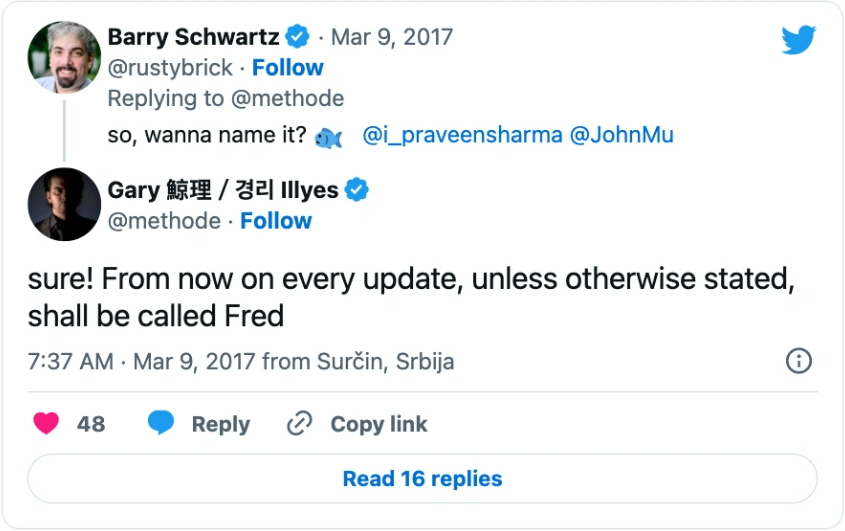
As for Fred’s impact, the same Barry Schwarz published research revealing roughly 95% of the sites/pages hit hardest had low-value content with high volumes of affiliate links.
Another analysis, published to TechWyse by Sreelal G. Pillai, suggested low quality backlinks were another common feature of affected domains.
In other words, sites that prioritised monetisation over user experience were firmly in Fred’s crosshairs.
Guidance included reducing ad saturation, evaluating link profiles, and assessing overall site structure.
January 2017 Intrusive Interstitials Penalty
- Launched: January 10
- Completed: Mid-to-late January
- Scale: Global
- Purpose: Penalise mobile pages with intrusive pop-ups and interstitials
- Impact: Sites using aggressive mobile interstitials saw ranking declines in mobile search results
Deviating from the norm, Google gave the digital community plenty of notice that the Intrusive Interstitials Penalty was coming — 6 months to be exact!
The heads-up from Google likely had to do with the fact it was a highly specific update with a simple fix… use fewer intrusive pop-ups. It may also have been a clever way for Google to make SERPs more user friendly before they actually had the means to enforce any new penalties.
As a targeted update, impact was minor in scale, confined to sites using excessive intrusive interstitials.
Curious about the impact of pop-ups on your site? Read our guide: How do pop-ups affect SEO in 2025
2016 Google algorithm updates
September 2016 Penguin 4.0 Update
- Launched: September 27
- Completed: ~ October 12
- Scale: Global
- Purpose: Integrate Penguin into the core algorithm
- Impact: More granular, page-level penalties and quicker recovery for sites cleaning up bad links
Penguin 4.0 marked a major milestone by becoming part of Google’s core algorithm, rather than a separate filter. This shift meant that link spam and manipulative link-building tactics were evaluated in real-time, with ranking adjustments happening faster.
Unlike earlier versions that penalised entire sites, Penguin 4.0 could target individual pages, allowing for more precise ranking adjustments and quicker recovery once issues were resolved.
This update encouraged webmasters to maintain healthy backlink profiles, as the algorithm became more dynamic and responsive.
May 2016 Mobile-Friendly 2 Update
- Launched: May 1
- Completed: May 12
- Scale: Global
- Purpose: Strengthen mobile-friendly ranking signals in response to increasing mobile usage
- Impact: Sites not optimised for mobile devices experienced ranking declines on mobile SERPs
Building on the initial mobile-friendly update in 2015, this follow-up further boosted the ranking advantage for mobile-optimised pages - thereby pulling non-optimised pages down the SERPs.
The update evaluated pages individually, so non-mobile-friendly pages within an otherwise mobile-friendly site could still be impacted.
2015 Google algorithm updates
October 2015 RankBrain Update
- Launched: Spring 2015
- Completed: Announced October 26. Fully integrated by early 2016
- Scale: Global
- Purpose: Help Google better understand the intent behind searches
- Impact: Became one of Google's top ranking systems; significantly improved relevance of results for ambiguous searches
RankBrain was Google's first major application of artificial intelligence in search. Designed to interpret user intent behind unfamiliar or long-tail queries, and assess user interaction with search results, it uses machine learning to adjust rankings dynamically.
While initially limited in scope (applied to just 15% of fresh queries), it quickly scaled for use with all queries, regardless of ambiguity, length, or newness. It was eventually confirmed by Google as one of the most important aspects of their ranking approach.
Sites with clearly written, in-depth content using natural language and well aligned with user intent benefited the most from this update. Conversely, thin, generic, or misleading content optimised primarily for exact-match keywords began performing poorly.
Get a full introduction to Google’s RankBrain here.
July 2015 Panda 4.2 Update
- Launched: July 17
- Completed: Early 2016
- Scale: ~2-3% of English language queries
- Purpose: Penalise low-quality and duplicate content; promote rich, original material
- Impact: Changes appeared slowly; rankings shifted over time, making the update hard to analyse in isolation
This refresh of Panda was significant not for its aggressiveness, but for its drawn-out implementation. It allowed sites with improved content to recover gradually from previous penalties.
Low-quality sites saw slow, steady declines. Because of the gradual rollout, the SEO community found it difficult to attribute ranking changes directly to this update. A Google spokesperson eventually revealed that Panda had been incorporated into the core algorithm.
May 2015 Quality Update
- Launched: May 3
- Completed: Unknown
- Scale: Global
- Purpose: Refine core quality signals; target poor UX, thin content, aggressive monetisation
- Impact: Sudden traffic shifts for many publishers, especially those relying on low-value content
At first dubbed "Phantom" due to the lack of confirmation from Google, this update quietly rolled out with widespread effects.
It adjusted the core algorithm, improving Google’s ability to evaluate overall site quality rather than specific elements like backlinks or keyword density.
Sites heavy on ads, clickbait, or low-value content were most vulnerable.
April 2015 Mobile-Friendly “Mobilegeddon” Update
- Launched: April 21
- Completed: May
- Scale: Global
- Purpose: Promote mobile-optimised sites in mobile search
- Impact: Rankings dropped for sites not mobile-friendly; marked the beginning of “mobile-first” SEO
The Mobile-Friendly Update sparked a wave of urgency among site owners. Google began favouring mobile-friendly sites in mobile search results, a prescient move as mobile traffic began to overtake desktop shortly after rollout.
It didn’t destroy rankings across the board as predicted by some ("Mobilegeddon" was somewhat overblown), but it had a clear long-term impact: responsive design became standard, and mobile usability a core SEO requirement.
This update focused on mobile rankings exclusively — website performance on desktop was unaffected.
2014 Google algorithm updates
July 2014 Pigeon Update (international expansion)
- Launched: ~ December 15
- Completed: December 22
- Scale: UK, Canada, Australia
- Purpose: Expand the US-launched Pigeon local algorithm to additional English-speaking markets
- Impact: Reshuffled local pack rankings; organic authority became more important than pure proximity
The Pigeon expansion brought the established ranking changes—favouring traditional web signals in local results—to all English-language countries.
Small and medium UK, Canada and Australia-based businesses with strong SEO foundations gained more local visibility, while some lesser optimised outfits saw ranking declines despite proximity relevance to queries.
During this update, Google reduced local business listings in the SERPs from seven to three, intensifying competition for those top spots — but significantly increasing visibility and click-through potential for businesses that made the cut.
October 2014 Penguin 3.0 Update
- Launched: October 17
- Completed: December 6
- Scale: Global
- Purpose: Acknowledge improvements made to websites hit by the previous Penguin Update
- Impact: Modest but widespread ranking fluctuations
This wasn’t a new algorithm, but a refresh allowing cleanup efforts (e.g., disavowing spammy backlinks) to be reflected in rankings. It was long-awaited by webmasters penalised under earlier Penguin iterations. Since it rolled out slowly, tracking its impact was complex.
October Pirate 2.0 Update
- Launched: October 12
- Completed: October 21
- Scale: Global
- Purpose: To further demote websites hosting or linking to pirated content, based on DMCA complaints
- Impact: Major traffic drops for torrent and illegal streaming sites
An update to the original 2012 Pirate algorithm, Pirate 2.0 had a narrow but dramatic impact on torrent and illegal download sites. Google began applying stricter filters based on the volume of valid DMCA takedown requests.
High-profile sites like The Pirate Bay experienced steep visibility losses. For most legal websites, however, the update had no noticeable effect.
September 2014 Panda 4.1 Update
- Launched: September 23
- Completed: October
- Scale: 3-5% of queries
- Purpose: Refine detection of thin or low-quality content
- Impact: Small to mid-sized sites with high-quality content saw gains; shallow content was hit
Panda 4.1 introduced new signals to detect thin content more precisely. It rewarded well-crafted niche sites and original publishers. At the same time, it reduced visibility for content farms, low-value directories, and mass-produced pages with minimal engagement.
July 2014 HTTPS/SSL Update
- Launched: August 6
- Completed: Unknown
- Scale: Global
- Purpose: Promote better web security via HTTPS
- Impact: Initially minimal ranking benefit; eventually contributed to widespread HTTPS adoption
Google used this update to nudge webmasters toward securing their sites. The signal was lightweight at launch but sent a clear message: HTTPS was the future. In time, security became a critical trust and UX factor, especially with Chrome marking HTTP as “Not Secure.”
July 2014 Pigeon Update
- Launched: July 24
- Completed: Early August
- Scale: US — English queries
- Purpose: To improve local search by incorporating traditional web ranking signals
- Impact: Major changes to local pack rankings; reduced visibility for some directory sites
Pigeon overhauled how local results were ranked, using signals like domain authority and content relevance in addition to location data.
The update caused fluctuations in local “7-pack” results, with some businesses vanishing and others taking their place based on stronger organic SEO. It also led to directory sites (like Yelp) regaining prominence in many local queries.
June 2014 Payday Loan Update 3.0
- Launched: June 12
- Completed: Late June
- Scale: Query specific
- Purpose: Combat spammy results for queries associated with high-abuse verticals
- Impact: Spam-heavy industries saw continued cleanup; white-hat sites largely unaffected
Just weeks after 2.0, Payday Loan 3.0 focused on different algorithmic signals. It hit ultra-aggressive black-hat SEO techniques and keyword-stuffed spam pages, particularly in abusive commercial niches.
Unlike Panda or Penguin, which targeted site-wide quality or backlink profiles, the Payday Loan update was query-specific. It aimed to clean up particularly spam-prone search terms—like "payday loans" or "buy Viagra online"—by applying stricter ranking criteria only when those queries were entered.
This meant websites weren't penalised, but their visibility for those high-risk terms could be heavily reduced.
May 2014 Panda Update 4.0
- Launched: May 20
- Completed: ~ May 30
- Scale: ~ 7.5% English language queries
- Purpose: Major overhaul of the Panda algorithm — improved precision in detecting low-quality content
- Impact: Significant ranking shifts; some large content farms were hit hard, while smaller high-quality sites saw gains
Disregarding the original Panda Update, the May 2014 4.0 iteration was the most expansive Panda development to date.
Panda 4.0 wasn’t just a data refresh — it was a substantial algorithmic update and rework of how Panda assessed content quality. It introduced refined quality signals to better identify thin, duplicate, or low-value content.
Well-known sites like eBay saw major visibility drops (reportedly losing up to 80% of certain traffic segments), which shocked many in the SEO world. Conversely, niche publishers with well-structured, useful content occasionally saw a surge in rankings.
May 2014 Payday Loan Update 2.0
- Launched: May 17 or 18
- Completed: Unknown
- Scale: ~ 0.3% of US queries
- Purpose: Improve detection of webspam and manipulative tactics in "very spammy" query spaces
- Impact: Aggressive demotion of sites using black-hat SEO in niches like payday loans, pharmaceuticals, and gambling
This update was a major rewrite of the original Payday Loan algorithm launched in 2013. It went beyond query-level filtering and introduced improved spam-detection techniques to catch manipulative link schemes, keyword stuffing, and hacked content used to dominate high-abuse SERPs.
It laid the groundwork for Payday Loan 3.0, which followed just a month later and targeted a different set of spam signals.
Google clarified that it wasn’t based on user location or languages, but rather on spammy query types. Unlike broader updates, most legitimate websites remained unaffected unless they were trying to rank in these high-abuse niches using shady tactics.
May 2014 Page Layout Refresh
- Launched: May 19
- Completed: Within days
- Scale: Unknown
- Purpose: Refresh of the "Top Heavy" algorithm penalising sites with excessive above-the-fold ads
- Impact: Sites previously penalised could recover if they improved layout; others were newly impacted
This was the third known refresh of Google's Page Layout Algorithm, originally introduced in 2012. It penalised websites that placed too many ads above the fold, diminishing the user experience by making users scroll past ads to reach actual content.
The May 2014 refresh didn’t introduce new logic — it simply re-ran the algorithm, recalculating affected sites. Those that had reduced intrusive ad placements had the opportunity to regain rankings, while others that continued the practice could see new losses.
2013 Google algorithm updates
October 2013 Penguin 2.1 Update
- Launched: October 4
- Completed: October 4
- Scale: ~1% of queries
- Purpose: Data refresh and deeper crawling to detect spammy link profiles
- Impact: Penalised sites using low-quality backlinks; some hit harder than with 2.0
Penguin 2.1 expanded on the deeper analysis introduced in 2.0, targeting link spam not just at the homepage level but also in internal pages and link networks.
It caught more sophisticated black-hat tactics. Sites with poor-quality backlinks (e.g., comment spam, low-quality directories) lost rankings unless proactive disavowal or cleanup was done.
September 2013 Hummingbird Update
- Launched: Unknown
- Completed: ~ August 26 — announced September 26
- Scale: Global. 90% of searches
- Purpose: Complete overhaul of Google’s core algorithm for semantic understanding and conversational queries
- Impact: Massive infrastructure change; subtle front-end effects for most users
Not strictly an update — Hummingbird was a rebuild of the entire search engine algorithm, designed to better understand context and intent, not just keywords. It laid the foundation for voice search, featured snippets, and later AI-based systems like BERT.
Hummingbird was named so because it was a much swifter and more accurate than the preceeding algorithm.
As Google Software Engineer Matt Cutts reported in talks with Search Engine Journal, Hummingbird was largely unrelated to SEO. But it did impact the efficacy of a particular SEO tactic — the targeting of several long-tail keywords.
Before Hummingbird, spammy websites could exploit large volumes of low-competition, long-tail keywords to attract traffic at scale — monetising through aggressive ad placements with minimal content value.
Post update, this was no longer a winning strategy. Unfortunately, however, some legitimate websites targeting niche keywords as part of a white hat SEO strategy were also impacted by Hummingbird.
June 2013 Payday Loan Update
- Launched: June 11
- Completed: July or August
- Scale: US initially (~ 0.3% of searches) — later expanded globally (~4% of searches)
- Purpose: Tackle extreme webspam in high-abuse industries
- Impact: Widespread demotions of black-hat SEO pages in spammy niches
This was the first version of the Payday Loan algorithm. It went beyond Penguin to address ultra-spammy tactics dominating SERPs for risky queries. Google explicitly said the update wasn't language- or region-specific, warning that spammy tactics — no matter where they occurred — would be demoted in these niches.
June 2013 Penguin 2.0 Update
- Launched: May 22
- Completed: Likely the same day
- Scale: ~2.3% of English queries
- Purpose: Introduce a more comprehensive version of Penguin
- Impact: Targeted spam at a deeper page level; new link spam types affected
Penguin 2.0 extended spam analysis beyond homepages, reaching internal and subdomain pages where manipulative linking was common. It refined detection of link schemes, such as unnatural anchor text distribution, link wheels, and paid links. It was particularly damaging to affiliate-heavy or automated link-building schemes.
May 2013 Domain Crowding Update
- Launched: May 21
- Completed: Within days
- Scale: Global
- Purpose: Reduce the number of results from the same domain in a single SERP
- Impact: Increased diversity in search results; large brands lost redundant listings
This refinement addressed “crowding,” where a single domain (e.g., Amazon or Yelp) might occupy 4–5 of the top results. Google began limiting multiple listings from the same domain unless the query clearly indicated brand intent. This gave smaller or mid-tier sites more visibility on page one.
2012 Google algorithm updates
October 2012 Penguin 1.2 Update
- Launched: October 5
- Completed: Within days
- Scale: Global
- Purpose: Data refresh and push to other languages
- Impact: International expansion of Penguin effects; more spammy link profiles targeted worldwide
This third Penguin update (though called 1.2) extended Penguin beyond English, affecting languages where link spam was prevalent. It also allowed sites that had cleaned up their backlink profiles a chance to recover.
September Exact Match Domain (EMD) Update
- Launched: September 27
- Completed: Within a few days
- Scale: ~0.6% of English queries
- Purpose: Reduce the ranking boost given to exact-match domains with low-quality content
- Impact: Many spammy EMDs saw major ranking drops
Prior to this update, it was relatively easy to rank well with a domain like "bestmortgagerates.com", even if the content was poor. The EMD update reduced this bias, forcing such sites to compete on actual content quality. High-quality EMDs could still perform well.
According to a report published by Search Engine Journal, websites with non-.com TLDs were, on the whole, hit harder than .com domains.
April 2012 Penguin 1,1 Update
- Launched: May 25
- Completed: Within days
- Scale: ~0.1% of English queries
- Purpose: First data refresh of Penguin
- Impact: Allowed sites that cleaned up their link profiles to recover; hit new offenders
Penguin 1.1 didn’t add new logic but re-ran the Penguin filter. Sites that had aggressively disavowed bad links or cleaned up spammy profiles could regain rankings, while fresh offenders saw penalties applied.
Knowledge Graph Expansion
- Launched: May 16
- Completed: Gradually over time
- Scale: Global
- Purpose: Broaden Knowledge Graph results beyond US English
- Impact: More Knowledge Panels appearing in non-English SERPs
The Knowledge Graph, first launched in 2012, expanded to cover more countries and languages in May. Knowledge Panels began appearing more frequently in global SERPs, further shifting certain traffic away from traditional organic links.
April 2012 Penguin 1.0 Update
- Launched: April 24
- Completed: Within days
- Scale: ~3.1% of English queries
- Purpose: Introduce a new algorithm targeting link spam and manipulative SEO tactics
- Impact: Major traffic drops for sites using link schemes; a seismic moment in SEO
Penguin 1.0 was a landmark update that targeted webspam, unnatural link profiles, and manipulative anchor text. Unlike Panda, which focused on content quality, Penguin hit off-page signals — specifically spammy backlinks. Many sites relying on exact-match anchor text and link schemes were devastated.
February 2012 Venice Update
- Launched: February 27
- Completed: Early March
- Scale: Global
- Purpose: Introduce local search results into Google’s main organic listings more deeply
- Impact: More localised organic SERPs based on user location
Venice marked an important step in Google’s localisation strategy. It enabled local results to appear in the main organic listings, not just in map packs. This allowed small businesses with strong local signals to compete more effectively in geographically relevant queries.
While this was exactly what smaller businesses had been hoping for, results weren’t entirely positive. It brought the pre-existing local spam issue Google was facing into focus, with black-hat SEOs manipulating local relevence signals to get non-local businesses and websites to the top of the SERPs.
January 2012 Page Layout Update (Top Heavy 1)
- Launched: January 19
- Completed: Swiftly after launch
- Scale: ~1% of English queries
- Purpose: Penalise sites with excessive ad content above the fold
- Impact: Sites with poor UX and ad-heavy designs saw demotions
The first Page Layout Algorithm (nicknamed "Top Heavy" and sometimes referred to as the ‘Above the Fold’ Update) penalised pages that made it hard for users to find actual content due to static ads positioned above the fold.
2011 Google algorithm updates
November 2011 Freshness Update
- Launched: November 3
- Completed: Unknown
- Scale: Roughly 35% of searches globally
- Purpose: Prioritise fresher results for time-sensitive queries
- Impact: Significant — news sites, blogs, and rapidly updated content gained visibility
Building on the foundation set by 2010’s Caffeiene Update, the Frenshness Update focused on surfacing recently published content, especially for time-sensitive queries regarding news, events, politics, celebrities, and trends.
This was Google’s way of preparing for a future in which, by 2017, the volume of data created in a single year was projected to exceed the total generated over the previous five millennia of human history — a consequence of the rapid expansion and democratisation of the digital world.
By prioritising fresh content for 35% of global queries, Google was ensuring that users were being served the most relevant, up-to-date information.
It also put pressure on static content sites that relied on long-standing rankings. Website owners needed to invest in ongoing content updates to remain competitive in freshness-driven verticals.
April 2011 Panda 2.0 Update
- Launched: April 11
- Completed: Within days
- Scale: English queries globally
- Purpose: Expand Panda beyond US; add new signals (e.g., user data)
- Impact: Major — many English content sites saw new ranking shifts
Panda 2.0 took Panda 1.0 global — impacting English queries worldwide. It also introduced additional quality signals rooted in user engagement metrics to further refine the quality model.
Following Panda 2.0, Google would release 7 more Panda Updates. However, these were more refreshes than overhauls, recorded using decimal versioning, i.e. 2.1, 2.2, 2.3, etc. Each focused on a highly specific element:
1. Panda 2.1 - May: Refining content quality scoring and reducing false positives from the initial rollout
2. Panda 2.2 - June: Improving Google’s ability to differentiate between original content and copied material — particularly in competitive verticals like news, reviews, and product content. Scraper sites lost visibility
3. Panda 2.3 - July: Minor quality refinements — targeting thin and low-trust content — while continuing the monthly Panda refresh cycle
4. Panda 2.4 - August: Extend Panda to non-English languages (except Chinese, Japanese, Korean)
5. Panda 2.5 - September/October: Continued refinement of Panda that saw some reversals of previous Panda winners. Generally seen as an overcorrection in some areas, smoothed over by minor iterations Panda 2.5.1, Panda 2.5,2, and Panda 2.5.3
6. Panda #9 - November: Appeared to better detect low-trust signals, such as:
- Poor site architecture
- Duplicate internal content
- Over-reliance on affiliate links
- Lack of editorial oversight
7. Panda #10 - December: Another data refresh, continuing to reward high-quality, original content and devalue thin or duplicate material. Many SEOs were now building content strategies explicitly with Panda’s quality criteria in mind
February 2011 Panda 1.0 Update
- Launched: February 23
- Completed: ~ March-end
- Scale: ~12% of English queries
- Purpose: Target low-quality content farms and thin content
- Impact: Many major content farms lost massive traffic; SEO landscape shifted
Panda 1.0, originally known as the Farmer Update, was one of the most disruptive algorithm changes in Google’s history. It targeted sites with:
- Thin content
- High ad-to-content ratios
- Duplicate content
- Low trust or engagement
This update was designed to combat the increasing popularity of content farms — sites that mass-produced large volumes of low-quality, shallow content aimed solely at ranking in search results and driving ad revenue.
These sites were cluttering Google’s SERPs, often outranking more authoritative and useful sources, and degrading the overall quality of the search experience.
To create the update, Google first enlisted a team of human quality raters who were asked to evaluate websites based on questions like: Would you trust this site? Would you bookmark it? Does it provide genuine expertise?
Google then analysed which ranking signals correlated with these human judgments — such as content depth, originality, ad-to-content ratio, site trustworthiness, and user engagement. Using this data, Google trained a machine learning algorithm that could apply similar quality assessments at scale across the entire web.
Massive players like eHow, Associated Content, and Suite101 lost significant traffic. Conversely, many high-quality editorial and branded content sites gained visibility.
2010 Google algorithm updates
June 2010 Caffeine Update
- Launched: Early 2009
- Completed: June 8
- Scale: Global
- Purpose: Complete overhaul of Google’s indexing infrastructure for faster, fresher results
- Impact: Dramatically improved indexing speed and content freshness
Caffeine was a significant restructuring of Google’s index architecture. It was announced in August 2009, with Google inviting SEOs and developers to test it in a sandbox environment.
Previously, Google updated its index in large batches; Caffeine allowed for continuous, real-time indexing, meaning new content could appear in SERPs within seconds.
Google reported that Caffeine —
‘provides 50 percent fresher results for web searches than our last index, and it’s the latest collection of web content we’ve offered. Whether it’s a news story, a blog, or a forum post, you can now find links to relevant content much sooner after it is published than was possible ever before.’
This update also laid the technical foundation for later content-focused updates (like Panda) and the Freshness Update of 2011.
April 2010 MayDay Update
- Launched: April 28
- Completed: May 3
- Scale: Global
- Purpose: Improve quality of results for long-tail searches
- Impact: Content farms and thin affiliate sites lost ground on long-tail keywords
The May Day Update targeted thin content that had previously ranked well for long-tail queries.
Many affiliate marketers and content farms saw major losses as Google improved its ability to distinguish between genuinely useful niche content and pages designed solely to capture long-tail traffic without adding value.
This was an early step toward what would become the full-fledged Panda algorithm a year later.
2009 Google algorithm updates
January 2009 Vince Update
- Launched: January 18
- Completed: Unknown
- Scale: Global
- Purpose: Promote trustworthy, authoritative brands in search results
- Impact: Large, established brands saw improved rankings; small affiliates and thin sites lost ground
Dubbed the "Vince Update" (after the Google engineer who worked on it), this change boosted the visibility of major brands in Google’s organic results, particularly for commercial keywords (e.g. "laptops," "car insurance").
Google aimed to reward sites with strong trust signals — things like recognisable brand reputation, offline authority, and user trust — at a time when many SERPs were littered with thin affiliates and SEO-first content farms.
While this was a necessary move — it marked the beginning of the big-operator favouritism still rippling throughout Google’s SERPs today.
Google’s Matt Cutt’s responded to initial kickback, explaining that the update aimed to reward authority, trust, and relevance — as opposed to giving larger entities a leg up on the SERPs.
This contradicted an earlier (and refreshingly forthright) statement from then Google-CEO Eric Schmidt,
“The internet is fast becoming a cesspool where false information thrives … Brands are the solution, not the problem … Brands are how you sort out the cesspool … [Branding] may be an essential element that helps people navigate the world. Brand affinity is clearly hard wired. It is so fundamental to human existence that it’s not going away.’”
But whether intentional or not — data proved that the major names won the day.
Aaron Wall of SEOBook published an early analysis showing big brands in multiple verticals rising to peak places on the SERPs out of nowhere.
2008 Google algorithm updates
August 2008 Google Suggest
- Launched: August 1
- Completed: Immediately
- Scale: Global
- Purpose: Help users refine and complete queries faster via autosuggestions
- Impact: Shifted search behaviour; led SEOs to consider suggested terms in keyword targeting
Following years of testing (it was first launched in Google Labs in 2004), Google added dropdown query suggestions as users typed in the search bar.
While not an algorithmic ranking change, Google Suggest (now Google Autocomplete) had major indirect effects on SEO:
- Drove searchers toward popular suggested queries
- Influenced search demand for certain keywords
- Changed how people constructed and completed search phrases
- SEOs began analysing Google Suggest data to inform keyword research and content strategy
April 2008 Dewey Update
- Launched: April 1
- Completed: Mid-late April
- Scale: Global
- Purpose: Allegedly to tune internal Google systems and better surface Google-owned properties
- Impact: Fluctuations in SERPs
The Dewey Update caused noticeable SERP volatility. While Google did not disclose full details, many SEOs observed that it seemed to focus on link profile quality — namely, whether websites were using black hat link building techniques.
Some speculated Dewey was, in part, designed to favour Google’s own properties on their SERPs, but clear evidence for these claims was lacking.
As for the name, when Google’s Matt Cutts requested feedback on the impact of this update, he asked respondents to use the code word “dewey” on the form — as a way for Google to differentiate general feedback from feedback specific to this update.
Barry Schwarz of SERoundtable covered this request, adding…

Source: Search Engine Land
2007 Google algorithm updates
May 2007 Universal Search Update
- Launch: May 16
- Completed: After several months
- Scale: Global
- Purpose: Integrate results from multiple vertical search engines (video, news, images, local, books) into a single set of organic search results
- Impact: Changed the structure of Google’s SERPs
Universal Search was the beginning of the modern SERP. A significant step forward for Google, Universal Search allowed the blending of videos, news articles, images, maps, and books directly into the organic results.
For marketers, this meant that image SEO, video optimisation, Google News inclusion, and local SEO suddenly became important, opening new avenues for targeting audiences.
2006 Google algorithm updates
November 2006 Supplemental Update
- Launched: November 1
- Completed: Unknown
- Scale: Global
- Purpose: Improve handling of lower-quality or less frequently updated pages via a Supplemental Index
- Impact: Sites with thin content or poor link profiles saw more pages labelled as “Supplemental” and struggled to rank
Google maintained a Supplemental Index for pages it deemed lower quality or less relevant for high-profile queries. In late 2006, it refined how this index was used:
- More pages with low authority or thin content were pushed into Supplemental
- This meant those pages appeared only on very specific or long-tail searches, or not at all
- Pages marked as Supplemental struggled to attract traffic
For SEOs, this was a wake-up call to focus on site quality, internal linking, and content depth, since being pushed into the Supplemental Index effectively meant being de-prioritised by Google.
2005 Google algorithm updates
December 2005 Big Daddy Update
- Launched: December 2005
- Completed: March 2006
- Scale: Global
- Purpose: Overhaul Google’s link handling, canonicalisation, redirect processing, and indexing infrastructure
- Impact: Sites with poor technical SEO or manipulative linking practices experienced ranking volatility; many technical SEO best practices stemmed from this shift
The Big Daddy Update was not a traditional algorithm change but a deep infrastructure overhaul.
It improved how Google handled:
- Canonicalisation — understanding which version of a page to index
- Redirects — proper processing of 301 and 302 redirects
- Duplicate content handling
- Link quality evaluation
Early phases began testing in late 2005 and caused significant volatility in rankings for sites with poor technical setups. Big Daddy laid the groundwork for a more sophisticated understanding of site structure and link integrity.
September 2005 Jagger Update
- Launched: September 2005
- Completed: Phased rollout for weeks
- Scale: Global
- Purpose: Combat spammy backlinks and improve detection of unnatural link profiles
- Impact: Many sites with aggressive link-building tactics lost rankings; improved the overall quality of link signals
The Jagger Update focused heavily on link spam, targeting websites that manipulated rankings through low-quality or paid backlinks.
It improved Google’s ability to detect:
- Spammy link networks
- Over-optimised anchor text
- Manipulative link exchanges
Webmasters with aggressive or shady link-building strategies reported significant ranking drops after Jagger.
It was one of the first major steps toward Google’s ongoing war on link spam — a battle that would continue with later updates like Big Daddy and Penguin.
Many SEOs consider Jagger a foundational update in Google’s move toward quality over quantity in backlinks — a move that came to a head during the March 2024 core update.
2004 Google algorithm updates
February 2004 Brandy Update
- Launched: February 1
- Completed: After a few days
- Scale: Global
- Purpose: Improve handling of duplicate content and URL canonicalisation; enhance link authority distribution
- Impact: Sites with duplicate or near-duplicate content saw ranking adjustments; some previously penalised sites regained visibility
The Brandy Update built on earlier work tackling duplicate content and URL variations.
Key goals included:
- Better consolidation of duplicate or near-duplicate pages across domains and URL parameters
- Improved canonicalisation signals to attribute credit properly
- Enhanced ability to handle link authority distribution, especially where multiple URLs pointed to similar content
Webmasters noticed more stable rankings, especially for sites that had suffered from duplicate content issues.
2003 Google algorithm updates
November 2003 Florida Update
- Launched: ~ November 16
- Completed: ~ Early-to-mid December
- Scale: Global
- Purpose: Crack down on keyword stuffing, over-optimisation, and spammy SEO tactics
- Impact: Massive ranking volatility; many sites relying on manipulative tactics lost visibility
Google were tightlipped about the focus of the Florida Update, but based on the post-update SERPs, it seemed to be geared towards reducing visibility for sites and pages with spammy backlinks and/or lots of keyword stuffing.
As Google’s first attempt at a large-scale update, it’s unsurprising that there were some significant unintended consequences. Several genuine websites using standard SEO best practices (of the time) were dragged down the ranks alongside the black hats.
July 2003 Fritz Update
- Launched: July 1
- Completed: Within days
- Scale: Global
- Purpose: Move away from monthly index refreshes toward a continuous update model
- Impact: Rankings began updating daily instead of in large monthly batches; search results became more fluid
Pre July 2003, Google used a monthly index update model called Google Dance. Causing significant ranking volatility once a month, this approach created a highly unstable SERPs and long delays in getting webpages indexed.
Fritz was a more efficient model, processing index updates daily, smoothing out position changes, speeding up the indexing process, and making life a whole lot easier for SEOs and marketers.
February 2003 Boston Update
- Launched: February 1
- Completed: Unknown
- Scale: Global
- Purpose: Introduced regular updates and improvements to indexing and link analysis
- Impact: Moderate ranking shifts; signalled a new era of ongoing, frequent updates
This update was announced at the 2003 SES Boston Conference, hence the name. It was also the first to receive an official name.
Boston wasn’t a single focused algorithm change, but rather the start of regular monthly index refreshes — and is considered the beginning of Google’s steady de-prioritisation of keyword density as a ranking consideration.
After Boston, meta information became a more important aspect of SEO — though it’s worth noting that meta tags were key beforehand as well.
Stay ahead of Google’s next move with TDMP
Every Google algorithm update brings change — but with the right strategy, it also brings opportunity. Whether you need to recover from a ranking hit or want to strengthen your SEO for the future, TDMP can help. Contact us today and turn Google’s updates into your competitive advantage.

